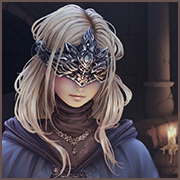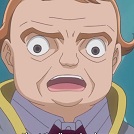|
Episode 31 (DS2 - 06): So the world might be m (Harvest Valley, Earthen Peak, Iron Keep)Chameleon(DS2) posted:A sorcery that dates farther back than recollection. Dark Souls 2 is such obvious bullshit. For me this realization was fairly immediate. At first this was off-putting, to put it lightly. The more I interact with it though, the more I find it to be the core of its charm. People like to fixate on the apparent impossibility of Iron Keep being located above the Earthen Peak, but forget that for the moment. Why are these areas even called "Harvest Valley" and "Earthen Peak" in the first place? Earthen Peak appears to be a windmill. A windmill is a man-made structure and therefore not a peak. 'Earthen' is actually more interesting. Initially I would be inclined to just interpret 'earthen' as meaning 'made of earth,' which would make 'Earthen Peak' a somewhat redundant phrase. But 'earthen' can also mean a floor or structure made of compressed earth, which actually explains the appearance of the internal brickwork of the area pretty well. It can also mean pots made of baked or fired clay, and poison-filled pots seem to be the only thing this place produces. So perhaps Earthen Peak is meaningfully named, but there's also a deliberate obfuscation going on. Harvest Valley is even worse. 'Harvest' is an extremely agriculture oriented term, and this area is very clearly dedicated to mining. This is a 'wrong thing.' For whatever reason you might be inclined to think this as an unimportant detail, but FromSoft makes sure to rub our faces in it a few areas later in Brightstone Cove Tseldora. Again we encounter a mining operation, and when we kill the miners, they sometimes drop the Peasant Attire. quote:Attire commonly worn by peasants. So let's address this by returning back to the allegory of Oolacile. Demon's Souls was supposed to be an open world competitor to the Elder Scrolls series, and open world games like Morrowind, Oblivion, and Skyrim have towns. Towns are also one of the most conspicuous things missing from the entire Soulsborne series, to the almost comedic extent that one of the few things we know about Elden Ring is that it will not have towns: quote:"Creating a new type of game is a big challenge for us," Miyazaki told IGN. "If we would add towns on top of that, it would become a bit too much, so we decided to create an open world style game focused on what we are best at.” We also know that the concept art for Dark Souls 2 included what appears to be a bustling and populated town environment quite unlike the barely populated ruins of Majula: 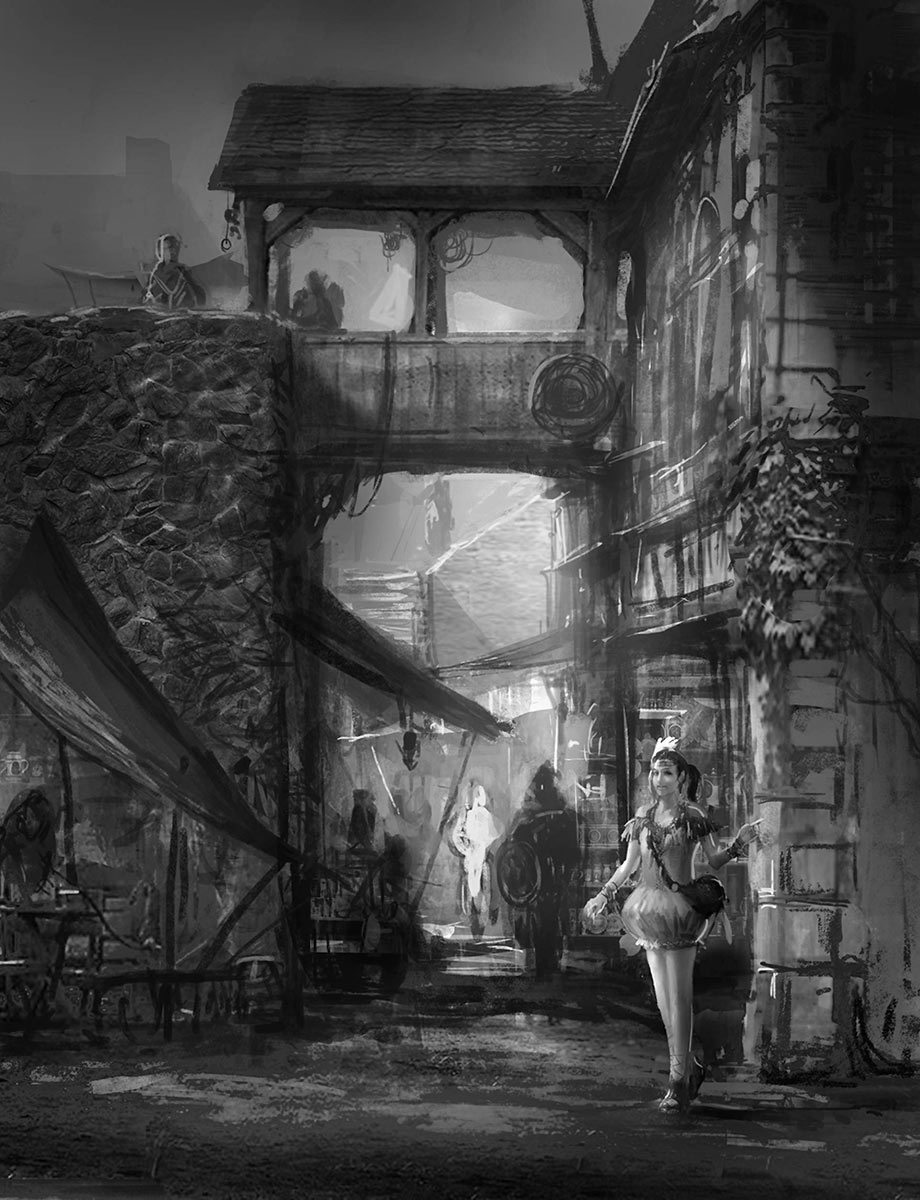  I believe that Oolacile is the in-narrative reference point for the civilization that was originally going to be found in Demon's Souls and that FromSoft attempted to recreate before whatever happened to Dark Souls happened. Hence, what we find in Harvest Valley was once the agrarian center of this civilization. This is why we find the Chameleon spell here which in DS1 is described as quote:Ancient sorcery of the lost land of Oolacile. Transform into something inconspicuous. and in DS3 as quote:Lost sorcery from Oolacile, land of ancient golden sorceries. Transforms into something inconspicuous. So what is it that killed off Oolacile? One way to think about it is a project getting a little too covetous, but I think through the use of the Pharros Contraptions we can get more direct than that (a conceit so important that a Pharros' Contraption in Iron Keep provides the same thing): 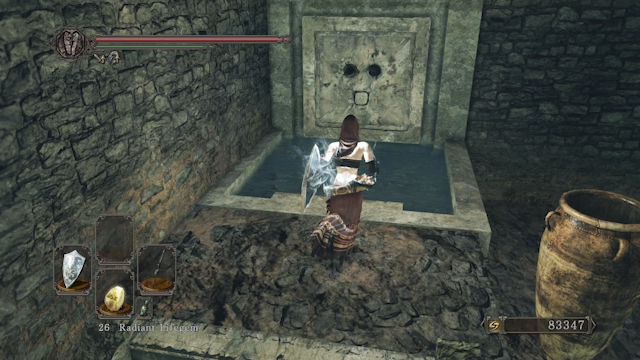 See, human settlements tend to be built along sources of water, and programming water is hard. There are so many instances of missing water in these games that my attempts to document them resulted in a script that would run longer than an hour that I shelved because who would watch an hour long video of "here's another peculiar bit of water-related world design." But missing water is everywhere, and it's meticulously preserved absence makes sense if your creation myth is a world abandoned in part because you couldn't make the necessary water not look like poo poo without absolutely killing the frame rate. Or without driving your foley artists insane: Enlarged Heat Patients, Research Hall, Bloodborne posted:Have you heard how curiously the sea churns? Oh Kos, how I love these games... Anyway, Harvest Valley in particular used to have water. https://peterbarnard1984.tumblr.com/post/113787568485/dark-souls-2-design-works-translation-part-2 posted:Satake: Originally the entire map was like a basin completely filled with poisonous fog. In the first design you would redirect the flow of water to start the windmills and that would clear the fog away. Of course that changed in the final game but I think ultimately it became a visually interesting location. There exists concept art of this design: 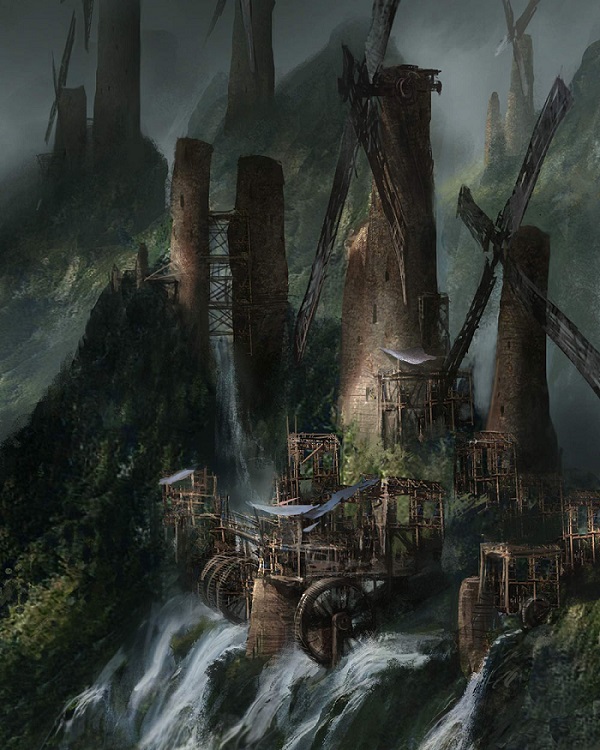 And I'd argue that we can even still operate what once was a water sluice near the beginning of the area:  The simple and straightforward read is that yet another one of the problems the pre-Demon's Souls open world game ran into was coding in water. So it was abandoned, and we instead get Demon's Souls as depicted in the visage of the Old Iron King. This failure is why Demon's Souls Valley of Defilement is what it is; because without flowing water all you're left with is an unclean swamp. So Dark Souls 2 chased the same dream and failed to realize it. But the complication is that Dark Souls 1 must have done the same thing too. Talking about Dusk prior to the release of DS1's Oolacile DLC: quote:Miyazaki: There was a removed event in early development where you would get summoned to Dusk's world. Her story was that she came from Oolacile, so there was a quest to rescue her in that kingdom after being summoned. We scrapped that quickly, though, "there's no way we can do that!". I wanted to make the old forest bright, and restore the ruins and buildings. So there you would do some quests in Oolacile, getting summoned by Dusk. It's sad, because she's a character I liked so much, so I was thinking about events and quests related to her. I don't think this was merely an "event." I think it was a completely different game direction that had to be abandoned. And while technical limitations explains some of the abandoned kingdom's recorded in these games, I don't think the same technical failure happened three separate times. So that has me wondering which failure was different and why? Whatever the case, FromSoft is very reliable when it comes to realizing incomplete ideas several games later. Just like how DS3's King of the Storm and Sekiro's Gyoubu Oniwa showcase all they learned about dragon and horse riding respectively, Sekiro finally starts to realize the dream of flowing water. In illusory wall's Dark Souls 2 Dissected: How the Gutter Got Gutted we see this extremely unfinished bit of architecture: 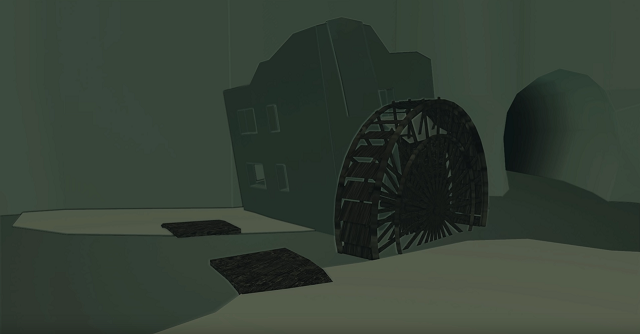 It took a while but they finally finished it. https://i.imgur.com/rYveIpa.gifv well...mostly... https://i.imgur.com/Ciy93sF.gifv I think they even eventually got around to finishing the water temple that eventually became Firelink Shrine: quote:Miyazaki: The Firelink Shrine was Mr (Daisuke) Satake wasn't it? https://i.imgur.com/iJoQZvP.gifv Unfortunately, it was completed a little too late. But I'm getting ahead of myself. For now, this post is getting too long so I'm turning it into a two parter. In part two we'll look at the ecosystems of Earthen Peak and Iron Keep, with a special focus on how the two areas are connected, because that connection certainly isn't happening in physical reality. There's also going to be an examination of the bosses of the area, especially Mytha. I think I find her to be the most interesting boss in the entire first half of the game.
|
|
|
|

|
| # ? Apr 20, 2024 00:53 |
|
Sibyl Disobedience posted:And I'd argue that we can even still operate what once was a water sluice near the beginning of the area: Another connection to Brightstone Cove is the presence of the Desert Sorceresses; while Harvest Valley is certainly barren, Brightstone Cove is a lot more overtly desert-coded (which leads to another interesting inversion: Anor Londo in DSIII was planned to have turned into a desert, but FromSoft ended up making it a snowy place by simply recolouring the sand – so this time the desert turned into (frozen) water). I think the whole Iron King story is kind of fascinating because everything is so deeply unclear, even by Souls standards. On the surface it's a stock fable about hubris and greed leading to a downfall, but then some of the item descriptions describe the Iron King's reign as "a great age of iron" like it was something on par with the ages of fire and dark, or it's mentioned that the Iron King's corpse became "the vessel that bred Ichorous Earth" as if it's just perfectly self-evident what "Ichorous Earth" is.
|
|
|
|
Carpator Diei posted:I think the whole Iron King story is kind of fascinating because everything is so deeply unclear, even by Souls standards. On the surface it's a stock fable about hubris and greed leading to a downfall, but then some of the item descriptions describe the Iron King's reign as "a great age of iron" like it was something on par with the ages of fire and dark, or it's mentioned that the Iron King's corpse became "the vessel that bred Ichorous Earth" as if it's just perfectly self-evident what "Ichorous Earth" is. It definitely helps that the Iron King got extra attention from the DLC that other lore found in the base game just didn't get. We already learn a fair bit about the Iron King through the base game, but then we get Brume Tower to further fill in gaps and show other aspects of what this Iron Kingdom was like.
|
|
|
|
Mutant Headcrab posted:It definitely helps that the Iron King got extra attention from the DLC that other lore found in the base game just didn't get. We already learn a fair bit about the Iron King through the base game, but then we get Brume Tower to further fill in gaps and show other aspects of what this Iron Kingdom was like.
|
|
|
|
Carpator Diei posted:On the surface it's a stock fable about hubris and greed leading to a downfall, but then some of the item descriptions describe the Iron King's reign as "a great age of iron" like it was something on par with the ages of fire and dark, or it's mentioned that the Iron King's corpse became "the vessel that bred Ichorous Earth" as if it's just perfectly self-evident what "Ichorous Earth" is. Isn't it though?  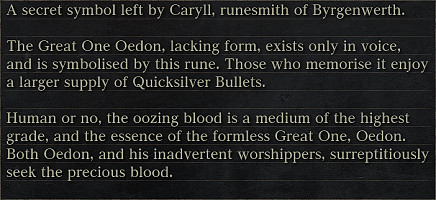 code:Carpator Diei posted:Another connection to Brightstone Cove is the presence of the Desert Sorceresses; while Harvest Valley is certainly barren, Brightstone Cove is a lot more overtly desert-coded (which leads to another interesting inversion: Anor Londo in DSIII was planned to have turned into a desert, but FromSoft ended up making it a snowy place by simply recolouring the sand so this time the desert turned into (frozen) water). FromSoft making that kind of change to Anor Londo does not mean they threw out the old idea entirely. What they're actually doing is invert the visual symbolism to find a more compelling visual expression. The end result is that we have the central idea of Anor Londo as a grand kingdom that has fallen to ruin, but we effectively have a multiverse of possibilities on how it has fallen to ruin. Aldia posted:Many monarchs have come and gone. One drowned in poison, another succumbed to flame. Still another slumbers in a realm of ice. Not one of them stood here, as you do now. You, conqueror of adversities. Give us your answer. "Drowned in poison" -- Anor Londo sinking into Blighttown becoming the Cathedral of the Deep. Expressed through Shulva of the DS2 DLC "succumbed to flame" -- Anor Londo lost to the desert, a concept never executed but represented via Iron Keep, Brume, Lost Izalith, and my particular favorites, Laurence's portion of the Hunter's Nightmare and the Ringed City post Filianore "slumbers in a realm of ice" -- Anor Londo and Irithyll, Frozen Eleum Loyce, and a couple other things we'll be getting to shortly In each branch of reality the same conceits get reincarnated in a form suiting the constraints of that particular branch. Hence, DS3's core reinterpretation of the Desert Sorceresses is likely Irithyll's Fire Witches (aka Burning Stake Witch): 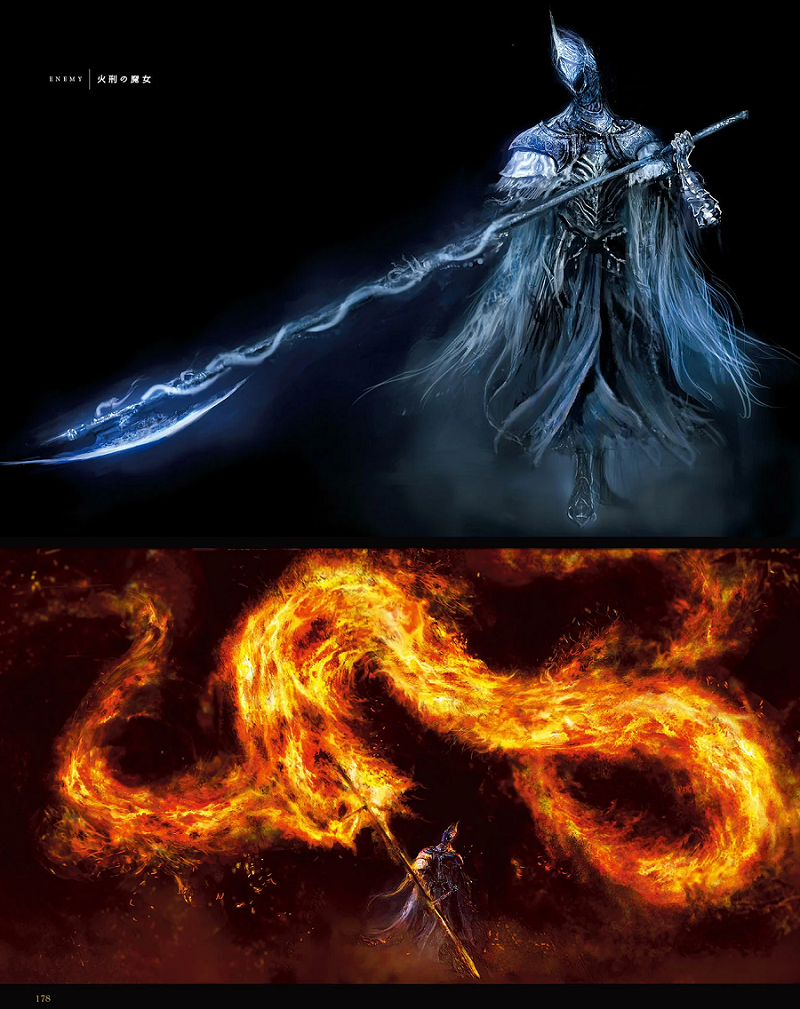 So the challenge here is that we're looking to distill a core, central mythos that we can then infuse back into each game individually to make sense of them. To make matters worse, FromSoft isn't making this easy with the intense degree of narrative layering at work here. Still, what I'm going to try to do is tell a single, incomplete story about what's going on between Earthen Peak and Iron Keep. It will be incomplete, but I think it's revelatory to the core of the inspiration of Dark Souls: a king and queen separated from one another: Bell Keeper's Seal posted:Ring of the Bell Keeper covenant. The separation is not necessarily a romantic one. DS2 is the only game that even hints at a romantic framing. DS3 seems to start to with Alva and Zullie, but then goes on to describe Zullie as: Black Witch Set posted:The purple (armor piece) of the witch Zullie, who intended to seduce Alva the Wayfarer, but eventually became his closest supporter, spending her entire life with him. Mood. Anyway, with that out of the way, let's find a way to make sense of how Harvest Valley, Earthen Peak, and Iron Keep connect to one another. ---------------------------------- It's About Time ---------------------------------- These areas are a physical impossibility. We take an elevator up from the peak of Earthen Peak to get to Iron Keep, but seen from the outside, Iron Keep is clearly not there. There's an essay called Iron Keep: A Castle in the Clouds that I really like that covers this more in detail. I'm going to crib a bit of their visual explanation: 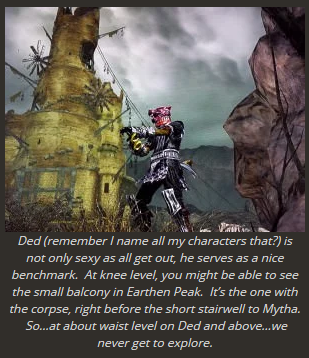 But as Solaire helpfully informed us, FromSoft is loving with both time and space. If we think of the elevator as a shrinking procedure, then it's easy to figure out what's going on. This "windmill" is actually a volcano and the opening at the top is it's mouth. The fire cleanses the poison and everything is eventually good...a couple years down the road. In the meantime, everyone in the vicinity gets the Vesuvius treatment. I just came up with most of this on the fly right now. It's the story connection I see in DS3 between Road of Sacrifices -> Farron Keep -> Smouldering Lake. Flame cleansing a poisonous swamp. The thing is, DS1 seems to work in the opposite direction. Blighttown, and specifically the Daughters of Chaos faction came out of Izalith to the poisonous swamp. But why should any of this surprise us? The flow of time is convoluted. So let's look at the Earthen Peak <-> Iron Keep vector in the other direction. Instead of Iron Keep being the response to Earthen Peak's poison, we're going to assume that Iron Keep is the cause of that poisoning. And how can we get to there? We assume that the physically impossible elevator represents us traveling back to the past. https://i.imgur.com/EeL6hbk.gifv The shifting design of the wall of the elevator ride even feels like we're passing through different layers of geological strata. Of course that's not going to be sufficient evidence to convince people of something as outlandish as time travel, so let's look at the ecosystem of the normal enemy types. Iron Keep is straightforward. 3 standard enemy types: Alonne Knight, Alonne Knight Captain, and Ironclad Soldier. All three of these possess straightforward connections to the Old Iron King. Alonne Greatbow posted:Unique bow equipped by Alonne Knights. Ironclad Helm posted:Helm worn by Ironclad soldiers. Provides high defense, but is so heavy that it requires great strength to move. But there is one weird bit in that we've seen the Ironclad Soldiers before back in the Forest of the Fallen Giants. In that area, their armor looked rusted and when they dropped it, it had both a different name and a conspicuously different narrative. Old Ironclad Helm posted:Old helm worn by Ironclad Soldiers. Boasts high defense, but extremely heavy. We don't find the Old Iron King anywhere near Drangleic castle, which suggests one of two things. 1. The Old Iron King is an imitator of the King of Drangleic castle, presumably Vendrick. This seems particularly weird since in DS2's phrasing the Old Iron King seems, well, old. Vendrick and Aldia appear to be recent enough that we still manage to communicate to both of them. 2. The Old Iron King is Vendrick. How exactly this works would have to be convoluted, to say the least. We'd have to be seeing the same narrative reinterpreted through multiple perspectives rather than distinct geographic locations during a roughly concurrent timeframe. But the more I look at it, the more that's the only way to interpret DS2 that has any sort of coherency at all. And honestly, 2 is the one I'm running with. Iron Keep represents the fall of the Old Iron King. Forest of the Fallen Giants represents the remnants of the kingdom several centuries later with the Ironclad Soldiers rusted and the kingdom itself in a state of disrepair. And you know, it's not important that you buy into this right now -- neither Old Iron King nor Vendrick are especially important to me -- but the discrepency between the Old Ironclads and the Iron Keep Ironclads is one that kinda demands an explanation, and the simplest explanation is 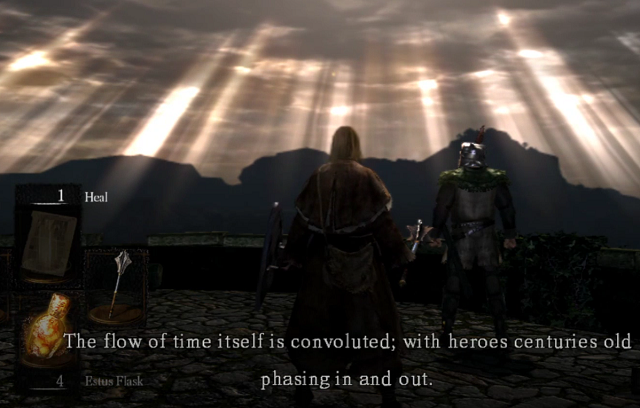 ---------------------------------- Who Would Create Such a Monster? ---------------------------------- We'll get to the enemies we find in Earthen Peak, but for our purposes right now, they almost exclusively have ties to Mytha, and none of their descriptions mention Old Iron King at all. It's Harvest Valley that appear to be the transitional area. Some of these will be quoting some DS2 Collector's Edition Guide that the wiki considers credible enough to include. First we have the Undead Huntsman/Artificial Undead that we encountered in Huntsman's Copse that we also find a pen-full of in Harvest Valley: quote:A massive, hulking beast of an Undead, this creature is disturbingly unnatural. This patchwork monstrosity wields two Full Moon Sickles and swings them with immense power.Who would create such a monster? The Iron King himself sought to destroy the Undead, not create them… The important bit here is that their creator is not identified. 1. The tailing elipsis could be implying that the Iron King was a bit of a hypocrite. 2. It could be that they were made by Mytha, as the ones in Huntsman's Copse drop the Rotten Pine Resin. But to my knowledge none of the Undead Huntsman ever poison you, so they could be a source for someone wanting to acquire poison (which could go some way as to explaining why Gavlan is found in the area and serves as a vendor for poisons) 3. Finally, the ones in Harvest Valley drop Dark Pine Resin. This could point to the involvement of a third party, which would help explain why Earthen Peak provides our first encounter with Agadyne's Grave Wardens. Other important bits is that their twin sickles is evocative of both Lautrec and the Darkmoon Covenant. Next, we have the skeletons of the area for which the guide actually gives a description! quote:The skeletons in this region are of unknown origins. They could be former subjects of the Iron King who were worked to death in the poisonous mines or poor Souls who wandered in more recently. Regardless, whether it was the massive Pools of Poison or giant monsters overseeing the Laborers, something killed these poor fools… but they've left it to you to finish the job. Finally, and most directly, we have the Steelworker Undead: quote:These brutish characters may have once worked for the Iron King in the construction of the many weapons and armors that he required, but now they are as Hollowed as the Laborers who slave away in the mines. There is a difference, however: strength. The Steelworkers heft huge hammers whereas the common laborers merely flail about with their arms. Couple interesting things about these enemies. First, they're not well adapted to all the stupid poison pots found in the area, as demonstrated by this encounter when we first enter the structure proper: https://i.imgur.com/CqWsCqz.gifv It's a sequence that goes out of its way to demonstrate that either the Steelworkers are a new arrival to the area or the poison is. Because as Sekiro put it:  The other weird thing about the Steelworkers is their proportions. Specifically, their legs feel too short. They kinda feel like oversized dwarves, but then the opposite of Gavlan whose legs might be too long. I'm honestly just genuinely perplexed on this point. In any case, my interpretation of that Earthen Peak is the remnants of the Old Iron King's kingdom, and Mytha's followers have infested the ruins and perhaps enslaved the remnants of the Old Iron King's civilian workforce. ---------------------------------- A Perilous Affront to All Life ---------------------------------- One of the major enemy types of Harvest Valley is the Banedigger (Mounted Overseer). quote:From atop gigantic monstrosoties capable of exerting tremendous amounts of dark power, weak overseers watch over the Laborers of Harvest Valley. The mounts have as much in common with demonic steeds as anything humanoid. Presumably their explicitly not a hex projectiles are related to the Hexing Urns we find early in the area. The dark themes are still weird in a stretch of the game that seems dominated by poison vs fire. But I think there are two hints as to what's going on. First, we have the Desert Sorceresses, shown here in embarassing moments just because I found them funny. 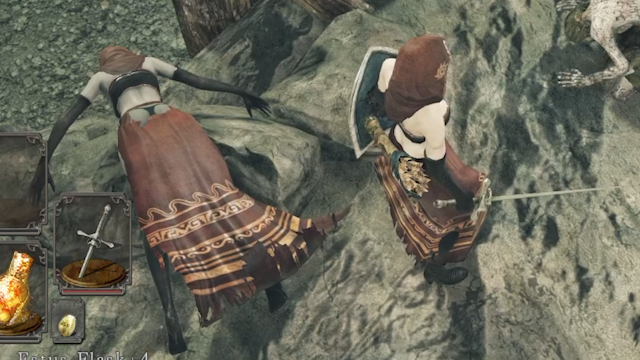 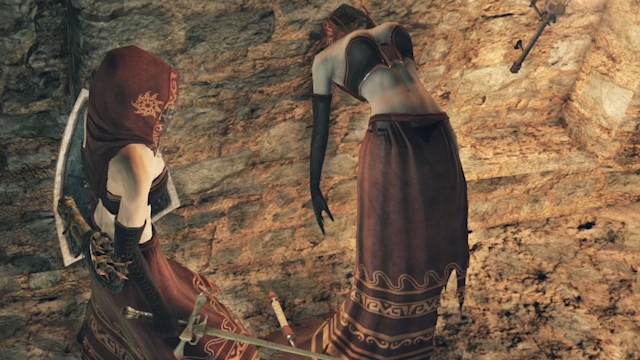 Sorceresses are interesting in that their name suggests they're using sorcery, but their spells appear to be pyromancy. I suspect that this is a callback to the witch Yuria from Demon's Souls. Demon's isn't my specialty, but in it Yuria and the main sorcery teacher Freke have some sort of rivalry, with Yuria's spells being both more oriented around fire, darkness, and the consumption of essence. Freke dips into these areas, but primarily starts by teaching you the standard blue glowy sorceries we see all over the place in Dark Souls. The dichotomy is also made clear in the Silver Demon Soul which Freke turns into Light Weapon and Yuria turns into Cursed Weapon. I say this all of this because not only do the Desert Sorceresses mostly use pyromancy, but the one non-pyromancy they cast is a fiery version of the hex Dark Hail. According to the wiki, it even more closely resembles Dark Bead from Oolacile of DS1, which is particularly interesting to me because one of the items the Desert Sorceresses can drop is the Wilted Dusk Herb which invokes Dusk, Oolacile's most famous resident. My belief is that Pyromancy in Dark Souls comes from a very similar place as Hexing, which -- as the spell description for Dark Hail puts it -- is both rooted in sorcery and miracles. Both of these stem from the dark sorcery we see in Oolacile, which are an attempt to replicate a miracle via a sorcery background. In DS1, this violation of magical boundaries is expressed in both the Tin Darkmoon Catalyst: quote:Catalyst born from the soul of the Dark Sun Gwyndolin, Darkmoon deity who watches over the abandoned city of the Gods, Anor Londo. and Velka's Talisman: quote:Medium for casting miracles of the Gods. So to sum it up, I think pyromancy is seen as a dark art in these games, or at least stemming from the dark arts. How this works in practice is still an open question for me. Are these games honest about what light actually is? DS1's opening states: quote:Even now there are only embers, and man sees not light, but only endless nights. And while that doesn't appear to be the case, if you grew up in a world where your only light came from blackflame, would you be able to conceive of the difference between it and true flame? Do the games always have to be honest showing us which is which? And are these games at heart more sympathetic towards the dark than what the item descriptions like Dark Bead's "viewed as a perilous affront to all life, and banned in most lands" would lead us to believe? ---------------------------------- The Peculiar Art of Puppetry ---------------------------------- In Earthen Peak proper we encounter the Manikins quote:These advanced puppets were given life by the Baneful Queen, and she uses them to lure unsuspecting fools into her traps. Once upon a time, the Manikins had heads, but the Queen ripped off their faces in a fit of rage. Watch yourself, or yours will be next. The Manikins have that whole missing head thing, which is noteworthy but not what I want to focus on right now. What I find most interesting is this bit: Manikin Claws posted:Claws used by the manikins of Harvest Valley. First, the bit about defiled valley? Pretty evocative of a certain bit of Demon's Souls. Second, it's interesting that puppetry is described as a vestige of two lands. This seems noteworthy because the Iron King seems to have his own form of puppets. Ironclad Set posted:Armor worn by Ironclad Soldiers. Provides high defense, but is so heavy that it requires great strength to move. But what's especially fun is comparing all of this to the Bell Keeper Set: quote:An old armor that is oddly comfortable. Belonged to a Bell Keeper. To this day, the forbidden love of Prince of Alken and the Princess of Venn manipulates these marionettes. Surely they never imagined that their dolls would outlast their own kingdoms. I think the implied antagonism between the Old Iron King and Mytha is a peek into Vendrick and Nashandra's breakup in a convoluted sense. The Manikin primarily use attacks that focus on bleeding and poison, which are the two types of weapon upgrade stones Stone Trader Chloanne starts selling us after we clear Nashandra's current haunt, Drangleic Castle. Both bleeds and poisons tend to be used in these games by forces that are technologically outmatched, and specific to the Ironclad Soldiers, their armor set is strong against bleed but weak to poison, which perhaps points in part to the emphasis on poison we see throughout Harvest Valley. Looking at this Vendrick/Nashandra pairing from the other direction, we have the Smelter Demon boss in Iron Keep Smelter Sword posted:An ultra greatsword forged from the soul of the Smelter Demon. Its blade bears the strength of terrible flames, a latent power unleashed by a strong attack. Couple ways to read this, but the one I'm interested in right now is the idea that the Old Iron King was usurped by the Smelter Demon. This is interesting to me, because I can now read the same thing into Vendrick through Velstadt, the King's Aegis. And okay, I'm jumping ahead here, so even though I hate it I'll try to lay down some exposition for anyone who somehow knows less about DS2 than I do. A couple areas in the future, we come across Velstadt who is guarding the rotten corpse of Vendrick in the Undead Crypt. We don't know a ton about why he's there, but I think there's a couple things we can read into his narrative. My understanding is that in Japanese his title translates to "the king's shield." I've seen people complain that "Aegis" is a weird choice, but I think this is one of those cases where the English translation is deliberate and more revealing. First of all, in Greek myth, the Aegis as carried by Athena and Zeus featured the head of a gorgon, which is kinda relevant here. 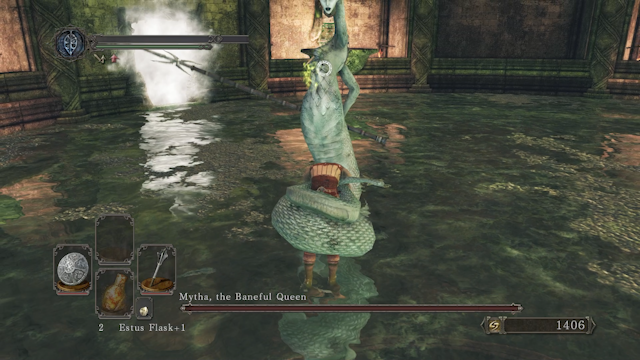 We also have the more modern sense of "aegis" as being an institutional enforcement, and I suspect that at some point Velstadt wrestled leadership away from Old King Vendrick, much like Smelter Demon appears to have led to the Old Iron King's downfall. Because if Velstadt didn't take control over the authority of the kingdom, how else do we explain Raime. Sigh...jumping ahead even further to the Iron Keep's DLC sister area, Brume Tower, we have the story of Fume Knight, aka Raime the Traitor and Rebel Raime -- Rebel's Greatshield: quote:Shield of the rebel Raime. The item description is pretty ambiguous as to whether the clash of wills was between Raime and Velstadt or Raime and Vendrick, and based on how Raime immediately goes into angy pyromancy mode if you wear Velstadt's helm, I suspect the big beef is between the two of them. Hence, Velstadt had the power to exile Raime and was ruling in Vendrick's stead at this point. Now how Mytha, Nashandra, and Nadalia, the Bride of Ash who Raime now serves interact is a bit sketchier of a question. I'm inclined to see them as vaguely resonant in a complicated way, but let's put Nadalia at least aside and examine Mytha in isolation. How Else Could She Forgive Those Who Dared Gaze Upon Her? So...I've talked about how there was going to be some trans stuff in this, and we're getting to a point where it's kinda unavoidable because a lot of the femme coded characters in this series seem to be suffering from dysphoria, which in this context specifically means a sense of distress at ones own physical appearance. I brought this up first with Gwyndolin's self-assessment in the Darkmoon Blade Covenant Ring: quote:Gwyndolin, all too aware of his repulsive, frail appearance, created the illusion of a sister Gwynevere, who helps him guard over Anor Londo. And I didn't really realize it until recording the footage for these last two episodes, but DS2 actually seems to give me dysphoria in that any time I slip off a cliff trying to record an animated gif I immediately have to pop a Human Effigy. Actually thinking about what I was doing made me feel silly and vain, but it's there. In any case, Gwyndolin is not alone when it comes to masked, femme-coded characters. From Dark Souls 1 we also have the Darkmoon Knightess, Firekeeper of Anor Londo: quote:Armor of the Darkmoon Knightess, Fire Keeper of Anor Londo. In Bloodborne we have Annalise, Queen of the Vilebloods: quote:Visitor… Moon-scented hunter… I am Annalise, Queen of Castle Cainhurst. Ruler of the Vilebloods, and sworn enemy of the church. Yet, our people are murdered, and we are prisoner to this wretched mask. What is it thou’rt in search of? In Dark Souls 3, Yuria wears the Billed Mask and sells us the Untrue Light and Dark Rings: quote:One of the illusory rings worn by the Hollows of Londor. of course we have Sister Friede of Dark Souls 3 and Lucatiel of Mirrah who shows up in Earthen Peak. Both have their faces covered enough to hide mirrored scarring along opposite eyes. Also in Earthen Peak we have the Desert Sorceresses themselves whose hood like Friede's conceals their faces: Given this history of feminine deformity, I find Mytha's story particularly interesting. As the Manikin set tells us: quote:A fickle queen gave them life, and tore off their faces. How else could she forgive those who dared gaze upon her? This introduces the idea of a baneful queen who demands not to be looked at, something that stood in my mind later when standing too close to Nashandra's portrait in Drangleic curses you. We also know from the Collector's Edition Guide's description of the Desert Sorceresses that Mytha is obsessed with the pursuit of beauty: quote:They were servants of Mytha before she ingested poison to seek beauty; even at present, they still follow the code of beauty, hiding their heads with hoods and wearing enchanting chestplates. They never hesitate to attack intruders who dare to stop Mytha from seeking beauty. And this brings up some heavy poo poo. "were servants" implies that Mytha is already dead, an idea reinforced by the fact that her boss chamber is guarded by Grave Wardens. More to the point, "ingested poison to seek beauty" kinda sounds like a suicide attempt. Or at least a botox injection gone horribly wrong. Furthermore, Mytha's soul gives us a motivation for this: quote:Soul of Mytha, the Baneful Queen, who lives in the Earthen Peak. "Sought the King's affection"...we only really have a handful of kings that could apply to, and it rather complicates any sort of straightforward antagonism between Mytha and the Old Iron King. So I'm going to create a juxtaposition here. I don't need you to believe that this connection is a real and intentional one. Just that it's an interesting framework to put over Mytha if only to see what happens. And that comparison is to Simone from Nier: Automata:  We have a shared doll theme, but more importantly we have an obsessive search for beauty surrounded the desire for the attention of a specific individual. A story we get a much more thorough look at on the second playthrough, when we're playing a character capable of hacking into her, which I'm going to take as a metaphor for the most forbidden of witchcraft: empathy. If you want to see the story for yourself, I put it up here: https://www.youtube.com/watch?v=RcYINnVt8EA As I've mentioned, like Mytha, Simone is obsessed with becoming beautiful to attract the attention of another character in the game. 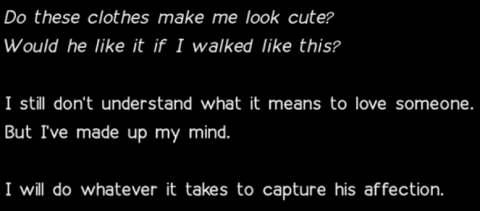 And as with Simone, it doesn't go well. 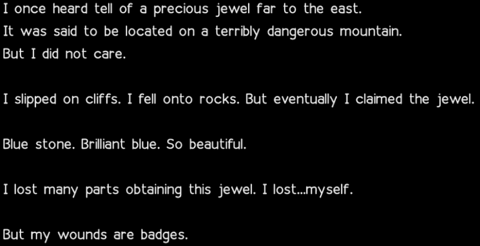  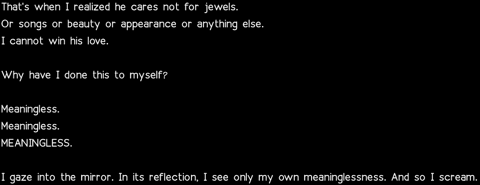  It's a poignant story, one that I kinda skimmed over on my first playthrough. But what I realized this time around is that, much like the Matrix, this is a trans allegory. I know people are going to say that stories are meant to be infinitely interpretable, that I am simply reading what I want to into the story, but that is not what's going on here. https://www.youtube.com/watch?v=X_bnPYuNmLM I'd prefer not to explain in detail the visual metaphor taking place here, so I'm going to just hope that given the context it is pretty obvious. Side note: listen to that cackle at the end. That bitch is feeling herself. Get it girl. To drive the point home further, at 1:45 and 4:33 we have voice acted bits of Simone's backstory that feature conspicuous jumps in voice pitch that get more intense further into the transition. Simone is doing voice training. This level of trans coding is not accidental. Cannot be accidental. If they denied it, I wouldn't believe them but would understand why plausible deniability is a practical concern. Is the portrayal a good one? Well, it gets dangerously close to the very wrong concept of transitioning only to attract attention of a particular gender, but it could alternatively be seen as expressing the very real danger of becoming obsessed with making changes to achieve a particular type of social acceptance ("Would he like it if I walked like this?"), which is a very real trap that people fall into. For now, I'm inclined to give Automata the benefit of the doubt on this. But moving back to Soulsborne, there's a very distinct presence of female characters being socially conditioned to feel shame for who they are. Yuria, the Witch (Demon's Souls) posted:I was branded a witch at a very young age, and since then, I have been persecuted as a threat to human society. Anastacia of Astora (Dark Souls 1) posted:...Forgive me...I am impure, my tongue never intended for restoration...Please, if you have any heart...Leave me be...I wish not to speak... Karla (Dark Souls 3) posted:You're here to save me...? These characters feel like abuse victims. Shamed for engaging in darkness, and specifically for engaging in witchcraft, a distinctly feminine art. With that in mind, let's go back to Licia from Heide's Tower, and specifically her Idol's Chime: quote:Sacred chime of Licia of Lindelt. A catalyst for miracles and hexes. I'm very much inclined to read this as queer encoded. Whether talking about sexuality or gender expression, the solution offered to "unusual urges" is staying closeted. To be clear, I don't think that the authorial intent is to endorse that viewpoint so much as to offer a brutal examination of it. And if you consider that Heide's forked structure and architecture invokes Anor Londo, Licia's locational equivalent in DS1 would be Gwyndolin, the idea of "unusual urges" and "act[ing] upon them out of the view of others" takes on a specific sort of tragedy. It's also disturbing how often female characters introduce themselves with the vague implication that they expect you to want to take sexual advantage for them. Arianna of Bloodborne is the most forward of these: quote:Oh, my, what a queer scent... But I'd take it over the stench of blood and beasts any day. What is it, then? I'm off during hunts, so if that's what you're here for, I'll leave you to your own devices. If that doesn't do it, come back in the morning, darling. But there are other, subtler examples. Stone Trader Chloanne who we come across in Harvest Valley could be read as invoking innuendo here: quote:You've been long away. What would you like? And then we have Karla from DS3: quote:Oh, there you are. There's a brutality to it all, but this is a brutal world, and having spent an absurd amount of time delving into these games, I truly believe they're deeply sympathetic to the plight. Possibly some of the most feminist works in mainstream media right now once you can unravel all of the subtext. The Dark Souls Design Works Interviews often have instances where they chide themselves for not doing enough for female representation quote:Ou:Out of my designs I’d probably say I’m happiest with the Black Witch set. The Dark Souls series doesn’t have all that many female characters so I think it’s an important addition and it was also a lot of fun to work on. But for my tastes, these games have more than their share of the best female representation in the industry, and I genuinely appreciate that. These are just things to think about when we consider the potential for allegorical messages in the games we play. ---------------------------------- Odds and Ends ---------------------------------- So, Earthen Peak includes some distinct size fuckery in how it uses pots. At the entrance of the structure, we have tiny pots and giant pots carefully segregated. The lower entrance is full of tiny pots making you feel like a giant as you walk through them. 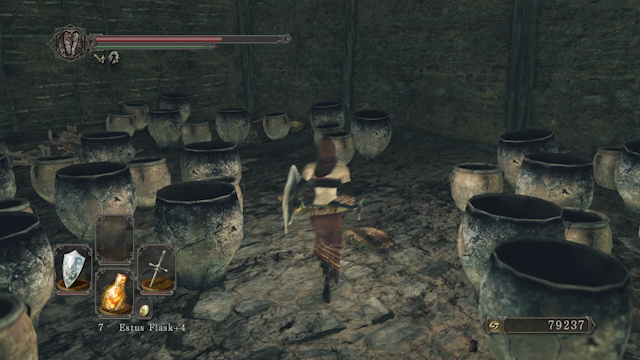 Meanwhile, the upper entrance has the bigger pots, but the weird thing about that is that after the Covetous Demon fight the pot size subtlety increases: 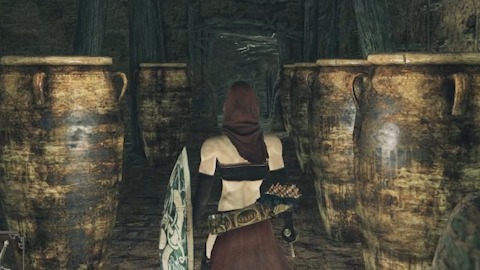 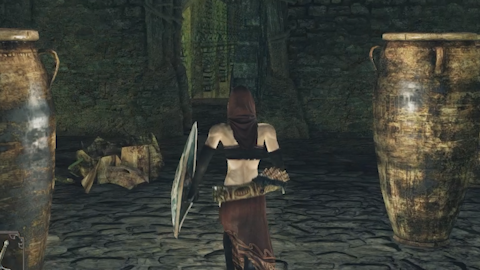 In the first pic from the first half, the PC's head goes up to the top of the handle, while in the second pic from the second half the head only goes to the bottom of the handle. It's such a seemingly unnecessary change that represents extra work that the overwhelming majority of players will never notice, which makes me suspect that it is deeply intentional. ---------------------------------- Mytha's room appears to exist in an earlier state of time. The statues outside her room look extremely ancient and dilapidated: 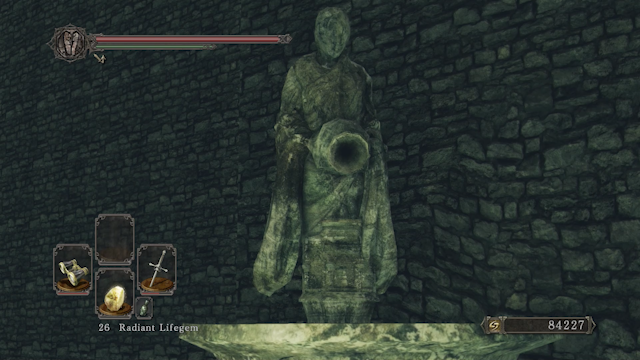 Meanwhile, the statues inside Mytha's room appear much more recent with a fresher paint job: 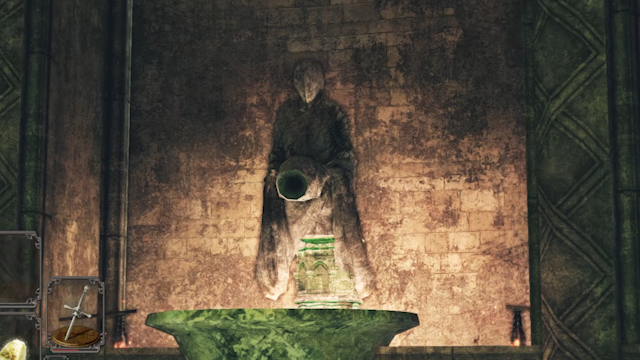 The lighting and masonry inside Mytha's room also appear to be in a dramatically less aged than the rest of Earthen Peak. ---------------------------------- Carp mentioned that Desert Sorceresses feel like they ought to be in Brightstone Cove Tseldora, due to Tseldora having much more of a desert theme. Maybe in a sense they are there. quote:The Desert Sorceress of Jugo project a very seductive image, and they use their looks to deceive others. In reality, even many who realized that this a trap fell prey to the Sorceresses' wiles. Perhaps they are part of Mythra's scheme to lure more victims into her web? "Lur[ing] more victims into her web[/i][/quote] is an interesting choice of metaphor. If we assume it to be less figurative than it appears, a connection to the last section of Tseldora suddenly emerges. ---------------------------------- Also, to highlight an implied schism between the Desert Sorceresses and the Alonne Knight Captains, the Desert Sorceresses drop Dragon Charms: quote:A blessed charm. quote:A blessed charm. The Desert Sorceresses appear to be the heir of genuine and more powerful tradition, while the monastery that Alonne is aligned with is explicitly a weaker imitation. ---------------------------------- What is Ichorous Earth? quote:Great hammer forged from the soul of the Old Iron King. Harvest Valley is rich with titanite, including a bit cluster in the place we find the Chameleon sorcery. I believe that titanite is the same thing as formless Oedon: the blood of a dead god and the technological breakthrough that poisoned their respective societies. What really is Earthen Peak. I believe that DS2 is in Bloodborne terms a 0 insight playthrough where our character simply does not and cannot understand what it is they are looking at. And if DS2 also is inspired by Don Quixote, and it also likes performing symbolic inversions, what is it that we might mistakenly identify as a windmill? ---------------------------------- I think I've finally hit the end of this monster of a post. I'm too exhausted at this point to offer any kind of neat tie up, but I will say that I think I can be done playing coy in the next update and get to the very core of what I believe Dark Souls is about. To be fair, it took me an embarassingly long time to realize it myself. So look forward to a story about something terrible and something wonderful.
|
|
|
|
Sibyl Disobedience posted:I think I've finally hit the end of this monster of a post. I'm too exhausted at this point to offer any kind of neat tie up, but I will say that I think I can be done playing coy in the next update and get to the very core of what I believe Dark Souls is about. To be fair, it took me an embarassingly long time to realize it myself. So look forward to a story about something terrible and something wonderful. I don't think I've ever been as excited for a post as I am for this one before. quote:"Lur[ing] more victims into her web" is an interesting choice of metaphor. If we assume it to be less figurative than it appears, a connection to the last section of Tseldora suddenly emerges. gently caress. That seems so obvious now! Vandar fucked around with this message at 09:20 on Apr 9, 2021 |
|
|
|
Harvest Valley, Earthen Peak, and Iron Keep all had enemy and item placements shuffled up between the original release and Scholar of the First Sin. Of the three, Iron Keep had it the worst with more knights added and placed so that it's even more difficult to kite them out. Iron Keep also had significantly more red phantoms added that invade as soon as you cross the initial bridge. There used to be a mimic in the Keep, but it and it's contents got yeeted into the Gutter. I'm super glad Sibyl mentioned the hammer undead and the pots. For whatever reason they massively ramped up the number of poison pots found throughout the Valley and the Peak. Any room or chamber that has pots in them had maybe half that number in the original release. They even filled the first bonfire of Harvest Valley with poison jars that weren't there in the first place. The mannikins... That led me down an interesting rabbit hole. I could have sworn they had heads in the original release, but I was mistaken. What I did find was that most of the wikis say that the mask from the mannikin set was redesigned prior to release. This stems from the games announcement trailer which depicted the bearer of the curse being surrounded and attacked by individuals wearing white glossy masks and wearing the mannikin set. The wikis claim the masks were changed for copyright reasons, but there's nothing I'm aware of which substantiates this. When the assailants are defeated, we're shown the curse bearer falling to his knees facing towards some very relevant volcanic imagery.  It's worth watching the entire announcement trailer as there is some interesting things in there, if only in retrospect. Mutant Headcrab fucked around with this message at 21:39 on Apr 9, 2021 |
|
|
|
Oh yeah, one last thing. The single summon available for fighting Mytha is Jester Thomas whose gear can be bought from Magerold of Lanafir. I have my thoughts about this whole setup, but they're forbidden for now. Independent of that, I just want to point out that one wiki, without offering a citation, says that the head artist stated that the original concept art was inspired by the end of the manga Usagi Drop. I bothered looking into what that could be referring to and what the gently caress? I think I'm going to assume that this is wiki vandalism until proven other wise, because it might be getting too weird even for me. And by the way, FromSoft's pre-Demon's Souls stuff is out of my scope right now, but if you're interested at all in King's Field a friend of mine has put together a big writeup about the narrative and themes of those games: https://twitter.com/angelnomoon/status/1378073704089927692 Mutant Headcrab posted:It's worth watching the entire announcement trailer as there is some interesting things in there, if only in retrospect. Yeah, between that trailer and the out-of-bounds examinations by illusorywall, it's really clear that DS2 got completely gutted.
|
|
|
|
Sibyl Disobedience posted:2. The Old Iron King is Vendrick. How exactly this works would have to be convoluted, to say the least. We'd have to be seeing the same narrative reinterpreted through multiple perspectives rather than distinct geographic locations during a roughly concurrent timeframe. But the more I look at it, the more that's the only way to interpret DS2 that has any sort of coherency at all. Sibyl Disobedience posted:There's a brutality to it all, but this is a brutal world, and having spent an absurd amount of time delving into these games, I truly believe they're deeply sympathetic to the plight. Possibly some of the most feminist works in mainstream media right now once you can unravel all of the subtext. Sibyl Disobedience posted:Independent of that, I just want to point out that one wiki, without offering a citation, says that the head artist stated that the original concept art was inspired by the end of the manga Usagi Drop. I bothered looking into what that could be referring to and what the gently caress? I think I'm going to assume that this is wiki vandalism until proven other wise, because it might be getting too weird even for me.  Uhmm yeah, that's probably some sort of hoax; I'm all for far-reaching thematic connections, but I absolutely can't see any sensible way in which that ending would be meaningful for anything in the Souls games (unless it's something completely peripheral, like some visuals being inspired by a particular panel layout). Uhmm yeah, that's probably some sort of hoax; I'm all for far-reaching thematic connections, but I absolutely can't see any sensible way in which that ending would be meaningful for anything in the Souls games (unless it's something completely peripheral, like some visuals being inspired by a particular panel layout).
|
|
|
|
In preparation for the big one, I want to take a little time to talk about the heretic storyteller:Storyteller's Staff posted:Staff of a heretic storyteller who shares tales of the Painted World to forlorn souls. Most people's first inclination when interpreting this item description would be to try to identify who the heretic storyteller is in-game. For instance, is it Karla? quote:Oh, there you are. Maybe, but that's not what I want to focus on. Breaking the fourth wall, what would it mean for a video game to tell a heretical story? What would the heresy be and how would you get away with it? To explore this, I want to talk about ending A for Nier: Automata, which means spoilers, albeit only obliquely. https://www.youtube.com/watch?v=L_FVJIwUhQY Let's cut to the chase. This is essentially a sex scene. This is particularly evident in their positions and movement, but it's also hinted at in the voice acting. The game conceals this obvious fact with the inclusion of two elements that sources assure me never show up during for-realsies human intercourse: choking and crying. Ostensibly, 2B needs to kill 9S so that his corrupted data doesn't get uploaded to their servers, but we already opened the game with a 2B/9S mutual suicide pact via controlled explosion, so we know that the Androids have methods to off themselves that don't entail the use of the cowgirl position. And yeah, I'm going out on a limb here and claim with certainty that this is all intentional.  Essays like this one make the argument that the asterisks prime us to fill in "gently caress," when it could easily be "save" or "love." Well, Ending A shows us a scene whose stated narrative tells us what's happening "kill," which distracts us from seeing the much more obvious "gently caress." Always important to keep in mind that the use of implication to conceal can work in a multitude of directions. All major media released in our world emerges out of a constant state of censorship, whether from semi-government institutions like the ESRB or from more internal pressures like publisher demands. Most of the time people expect this censorship to be focused on making sure series like Mortal Kombat don't get out of hand, but the truth is that when it comes to verbs, our collective cultural mores are lot more permissive towards "kill" than they are towards "gently caress" or even "love." When designing Drakengard, the precursor series to Nier, one of the central conceits was that the protagonist must be insane based on the premise that any protagonist that would casually murder thousands of people would have to be insane. But we live in a world where virtual genocide is an accepted hobby, so of course Ending A can only exist if we tell the audience that our character is choking someone to death. Because that makes it okay. While loving most definitely is not. Nier: Automata is also a game that repeatedly explores the theme of suicide while pretending that it's not. Besides the protagonists repeated use of suicide as a reset button, at one point in the game a robot faction engages in mass suicide in response to a particular event. But this is fine to show because as 9S tells us, "There's no meaning to anything the machines say." I want to ignore what any of this means inside the narrative, because what it means to the metanarrative is more important to me right now. And that is that if you're a video game writer and a heretic storyteller, the key to getting away with including your heresy is to simply lie about what is happening. You can do nearly anything as long as you frame it as a silly video game conceit. So just show what you want, call it something else, and hope that the obvious subtext leaks through. ---------------------------------------- But like I said, only some censorship comes from external pressures. We often forget that video game storytelling is a collaborative exercise, but just because you have a collaboration doesn't mean you agree on the details of what you're collaborating on. If a director can lie about the text in order to preserve subtext, then a lower level writer can do the same to get something past, say, a bigoted director. There's a whole discourse around the way Atlus handles the gender presentation of the character Naoto Shirogane in Persona 4. To anyone who knows the context, the character is very explicitly coded in a way that implies transmasculine themes, but the game itself directly undermines this in major story moments. People are inclined to give the entity "Altus" poo poo for this schizophrenic handling and eventual erasure, but "Atlus" is just an abstraction. The more likely explanation is that a writer had a story they wanted to tell, and an authority figure who was hostile to that story. So the lower-level writer engaged in heresy. They preserved what they could of the original concept in the less central moments of the game, hoping that the audience would notice this and in their outrage fix the damage done by the censor. Is bad representation better than no representation? I think it depends on the circumstances, but in this case I'm inclined to say yes. The idea of "Naota Shirogane" means more than any Disney movie with same-sex extras briefly kissing in the background so that it can be cut out of the Chinese theatrical release. Better to receive a meaningful character that has been butchered than to settle for disposable token representation. ---------------------------------------- Now how does this tie into Dark Souls? Well, you're just going to have wait and see. Let's just say I've developed a fondness towards the idea of a heretic storyteller. They sound to me like someone with an interest in secrets and nightmares. And I have something of an interest in nightmares. Simon the Harrowed posted:Ahh, yes, I see… Keeping Secrets, Threshold Kids, Control posted:Mr. Bones Sibyl Disobedience fucked around with this message at 17:38 on May 14, 2021 |
|
|
|
I'm ready to have my brain hurt.
|
|
|
|
Vandar posted:I'm ready to have my brain hurt. Sir Vilhelm posted:I've seen your kind, time and time again. It turns out Vilhelm wasn't exaggerating. I'd do it again in a heartbeat though.
|
|
|
|
I just wanted to let everyone following know that I haven't forgotten about this next update after all the teasing. It's just that this next bit is emotionally taxing to write about. In one sense I'm working on it non-stop, but the translation of that into actual words in the page is less consistently successful than I would like. As a more informative aside, I realized I forgot to mention something about No-man's Wharf. After I tore into the mob behavior and pathing issues in Friede's Tower of Flame, it's extremely relevant that the darkdwellers in the upper housing corners of No-man's show signs of a direct evolutionary upgrade in terms of threshold leashing behaviors. Specifically in how they display an emotional fear response to lit up areas as highlighted by the Pharros Contraption in the area. This exact behavior is replicated by the Beast Patients in Bloodborne's Old Yharnam, which is yet another example of DS2 serving as a prototype of sorts for Bloodborne.
|
|
|
|
Sibyl Disobedience posted:I just wanted to let everyone following know that I haven't forgotten about this next update after all the teasing. It's just that this next bit is emotionally taxing to write about. In one sense I'm working on it non-stop, but the translation of that into actual words in the page is less consistently successful than I would like.  Sibyl Disobedience posted:Friede's Tower of Flame 
|
|
|
|
The Undeath of the Author [Caitha]The King in Yellow by Robert William Chambers posted:If I had not caught a glimpse of the opening words in the second act I should never have finished it, but as I stooped to pick it up my eyes became riveted to the open page, and with a cry of terror, or perhaps it was of joy so poignant that I suffered in every nerve, I snatched the thing from the hearth and crept shaking to my bedroom, where I read it and reread it, and wept and laughed and trembled with a horror which at times assails me yet. This is the thing that troubles me, for I cannot forget Carcosa, where black stars hang in the heavens, where the shadows of men’s thoughts lengthen in the afternoon, when the twin suns sink into the Lake of Hali, and my mind will bear forever the memory of the Pallid mask. I pray God will curse the writer, as the writer has cursed the world with this beautiful, stupendous creation, terrible in its simplicity, irresistible in its truth--a world which now trembles before the King in Yellow.  Like Lot’s wife and Orpheus, I made the mistake of looking back. Except...is it really a mistake if, knowing what you know now, you’d do the exact same thing? It was in the middle of writing something entirely unrelated when I felt the need to look up what happened in the Dark Souls 3 DLC, because that’s just how my mind works. I had completed the base game a couple months earlier. Enjoyed it, but not quite as much as Bloodborne. I was curious to see what I had missed out on, and maybe it would help inspire a metaphor or two for my current project. That’s when I came across her, the Painting Woman, and her mystery has obsessed me ever since. 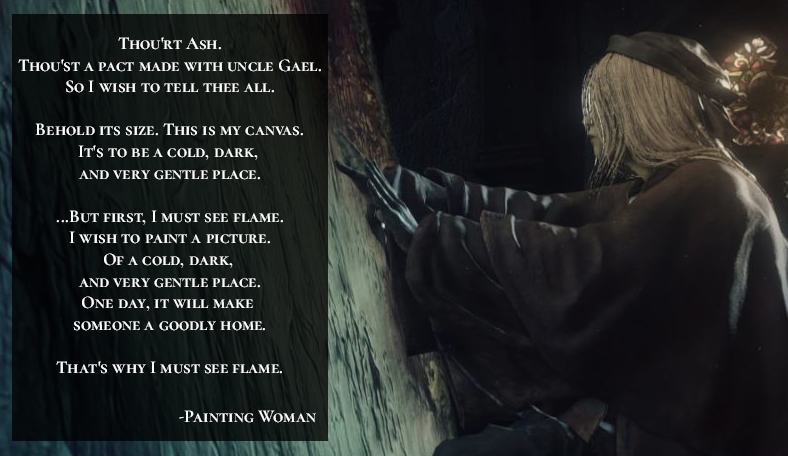 This is the point for me where I came to the unavoidable realization that Dark Souls was getting meta. The ending that I used to consider the unambiguously good ending had hinted at the idea of Dark Souls being a metanarrative about the creation of future flames and future worlds, but the Painted World was positively flooded with the conceit. And I needed to know why. Aldia, Scholar of the First Sin posted:There is no path. I started this thread with an almost arrogance that I had figured it out. That it was just metacommentary on how many design concepts over the years they had to unceremoniously throw away. I wasn’t exactly wrong, but I gradually realized during our time together here that this hypothesis was woefully incomplete. And now, after I buried the lede beneath tens of thousands of words and have lost the attention of most of the people who had initially been interested in the thread, I’m finally ready to uncover the central secret that makes these games so enthralling. The Rosetta Stone that translates the wondrous eldritch code that they speak in, that had previously hovered just on the edge of comprehension. 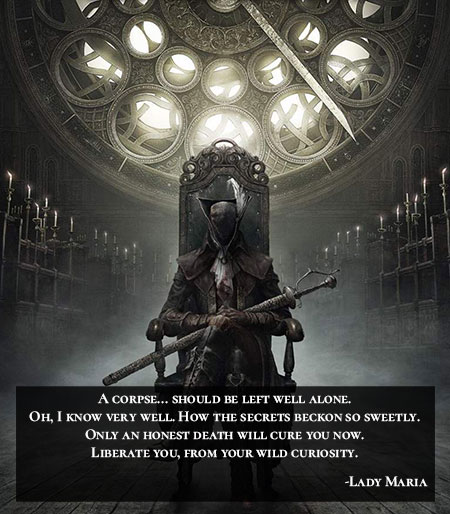 Sorry babe. The secrets beckoned far too sweetly. These games are literally a tomb. Their occupant is the most incredible individual in the history of video games. And we will never even know their name. Emerald Herald posted:Bearer of the curse, seek misery. For misery will lead you to greater, stronger souls. You will never meet the King with a soul so frail and pallid.  https://lovecraft.fandom.com/wiki/Mi-go posted:The Mi-go are pinkish, fungoid, crustacean-like entities with a "convoluted ellipsoid" composed of pyramided, fleshy rings and covered in antennae where a head would normally be. They are about 5-feet (1.5m) long, and their crustacean-like bodies bear numerous sets of paired appendages. They also possess a pair of membranous bat-like wings which are used to fly through the "ether" of outer space (a pre-Einsteinian concept). The wings do not function well on Earth. Several other races in Lovecraft's Mythos have wings like these as well, suggesting they are a standard mode of interplanetary travel. Micolash, Host of the Nightmare posted:Now I'm waking up, I'll forget everything... What Lovecraft-inspired game would be complete without everyone’s favorite brain preserving nightmare fuel, the Mi-go? Their presence in Bloodborne is subtle, but they’re the core reason the story is even taking place. The entirety of the Nightmare of Mensis is a brain cylinder. 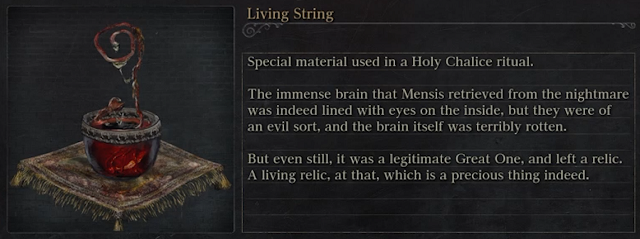 In Bloodborne’s Nightmare of Mensis, we climb the tower only to face Micolash in a twisting corridor of mirrors. After we defeat the echo of their existence, in searching through their archives we find the key that leads to the brain, which we then choose to contact for its insight or put to rest. Inclusive or. People joke that Micolash just thinks that it’s time to wake up, but that’s not what’s going on in the quote. There is a deep fear of mortality in the line “I’ll forget everything…” It reflects the type of personality for whom day-to-day life has been a nightmare. The dreamchaser, who chases in order to escape the soul-crushing grasp of the real. For whom the tragedy of dying has nothing to do with the death itself; the true loss of death is in forgetting the dream. Micolash is expressing the same fear every Soulsborne player has to learn to get over: the fear of losing all the souls you’ve collected when you die. But enough of the grand lore stuff. Let’s get to the nitty gritty. In true Lovecraftian melty-reality bullshit, the chalice dungeons are brains.  This first occurred to me when playing through the Loran chalice dungeons for someone. In it we find an inexplicable electrical rippling through the walls. https://i.imgur.com/o9tAg21.gifv The person I was playing it for pointed out that the electricity could be meant to represent the synaptic firing of neurons, and she’s absolutely correct. 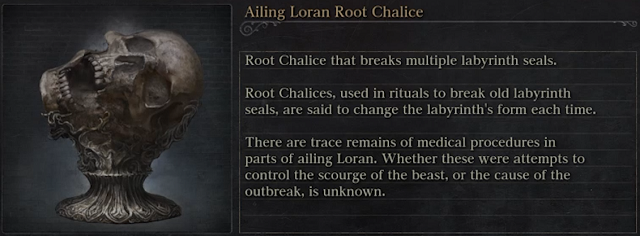 Loran is an ailing individual, hence why an ostensible kingdom can show evidence of“trace remains of medical procedures.” The three main chalice branches--Pthumeru, Loran, and Isz-- follow Aldia’s “prophecy” from Dark Souls 2: quote:Many monarchs have come and gone. One drowned in poison, another succumbed to flame. Still another slumbers in a realm of ice. Not one of them stood here, as you do now. You, conqueror of adversities. Give us your answer. The Isz chalice is simply a dying brain suspended in cryogenic storage. Aside from its icy visual depiction, there are two pieces of narrative symbolism that hint at the dungeon’s true nature. 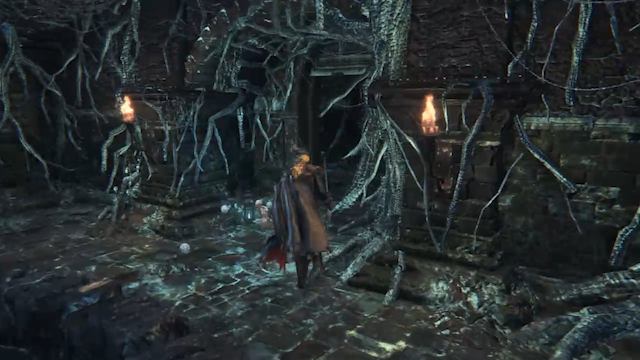 The first is the circular flower-looking objects in this screenshot are the Tomb Mold chalice material. 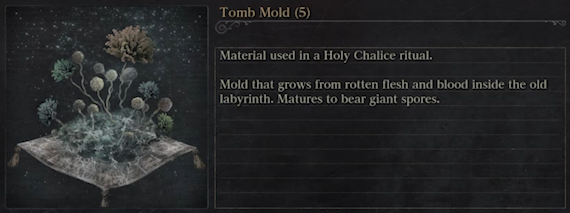 If the item description tells us that the mold grows from rotten flesh, and the mold appears to be growing from the stone floor of the labyrinth itself, then it simply follows that the floor is actually made of flesh. (Side note here: Some of my friends have speculated that the flowering we see in the icon for the rank 5 version of Tomb Mold is partially based off of hydrangeas. Flowers aren’t really my thing, but cultural symbolism for the hydrangea includes a Japanese legend where “the hydrangea became associated with heartfelt emotion, gratitude for understanding, and apology after a Japanese emperor gave them to the family of the girl he loved to make up for neglecting her in favor of business and show how much he cared about her.” Blue Hydrangeas also symbolize frigidity and apology. Whether this connection is correct, these themes will nevertheless come up in part two.) The other bit is the name of the chalice itself. “Isz” is a very strange word. Maybe someone was just a fan of the Maxx and that’s how Bloodborne got the Messengers. The more confident connection I can make is to [url=https://fileinfo.com/extension/isz]the .isz file extension, a format intended for high compression data storage. Actually a rather brilliant name for a brain cylinder. Once you accept that these games are a memorial for a specific individual, hidden meaning emerges from even the most mundane of item descriptions. Coldblood Dew: They imbibe the blood with thoughts of reverence, indeed gratitude, for their victims. Thick Coldblood: A strong will produces thick blood. Doubtless, the product of obsession, a potent source of human strength. Frenzied Coldblood: This manifestation of madness comes from a mind teetering on the very brink, but has a sane mind ever produced anything of true significance? Great One Coldblood: Like a true revelation, this uncanny relic defies understanding. Defies understanding? Challenge loving accepted. ...for a grander purpose, of course… 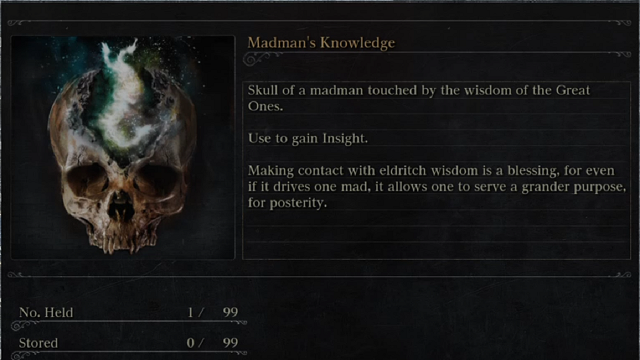  But soon the flames will fade and only Dark will remain. These games hit home so hard because the worlds themselves are literally grieving. https://i.imgur.com/kGY2FSb.gifv https://i.imgur.com/mXxwEKA.gifv https://i.imgur.com/rqY79Vk.gifv The worlds themselves are built on the corpses of the gods whose minds conceived them. Hence, we have the explanation for the repeated peculiarity of major individuals having residents. 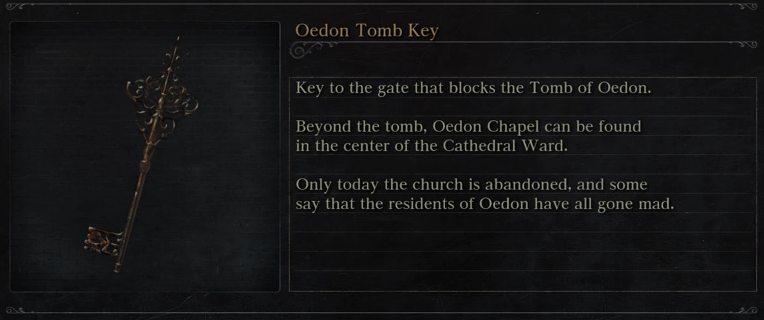 Northern Ritual Band (DS2) posted:One of the secret treasures restored in Aldia. And of course there’s the city of Yharnam itself. There’s no reason that the city couldn’t have been named after the Queen, but given that Oedon and Aldia have inhabitants, why not extend the trendline? Just think the Liliputians from Gulliver’s Travels but more internal. These games are constructed by linking together the dying embers of a single individual’s unfinished stories. Their final fantasy, if I may borrow a familiar phrase. As Hidetaka Miyazaki puts it: quote:... Dark Souls is in some ways an incomplete game, and I like to think that it has been completed by players, by their discoveries, as they moved along. I’d love to say that the nature of this incompleteness was completely deliberate, but it is both deliberate and by accident, in different ways. Or as Crestfallen Saulden of Majula puts it: quote:In Drangleic, the flow of time is convoluted. Things shift and waver, twist and turn. There’s an argument that convoluted is a mistranslation because the Japanese is closer to stagnating. Oh, the linguistic majesty these games employ. Time is both convoluted and stagnating. Time is becoming convoluted because it has stagnated. There can be no new time, so time is wrapping upon itself in its death throes. The repeating motif of the archtree pillars that we first see in Ash Lake of Dark Souls 1, then in The Things Betwixt of Dark Souls 2, and then again in the Hunter’s Dream of Bloodborne, they’re the memory storage of an endless fractal of worlds dying in unison. 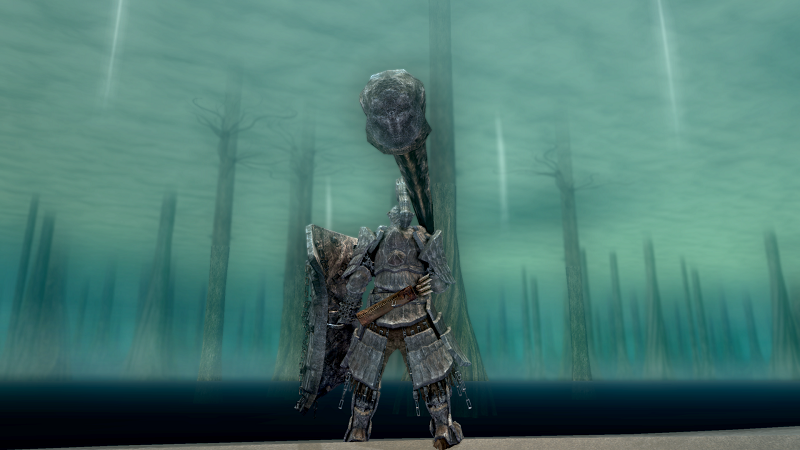 The narrative of all the NPCs in Dark Souls 2 forgetting who they are? Their pasts are disappearing because their creator is dead, and the neurons that held that information are no longer accessible, starting with the most ancient. Lucatiel of Mirrah posted:I've found my thoughts growing hazy.  Hidetaka Miyazaki, bloodborne-wiki.com/2017/01/interviews.html posted:From the very beginning of this project, the whole premise was to make a serious game for people who like games. On top of that premise, we have ultiple themes throughout the various layers of the game, but three big ones would be “exploring the unknown,” “the feeling of fighting for one’s life,” and “new online elements.” If I had to guess at a cause of death, I’d go with cancer. To a certain extent that’s just playing the actuarial table for someone likely in the 45-64 range, but cancer references lurk in the background, even if it is difficult to be certain of their placement on the spectrum between the metaphorical and the literal. One of the most straightforward ones is the Surgical Long Gloves of Bloodborne, with their description: quote:When a cancer is discovered, one must pinpoint its location, reach in, and wrench it from the host's bosom. One of the accompanying sets to these gloves, the Black Church Set, adds: quote:Most Healing Church hunters are elementary doctors who understand the importance of early prevention of the scourge. with "early prevention" being a conspicuous loan phrase from a reality outside of Yharnam. A more visual example of cancer is Rosaria, Mother of Rebirth: 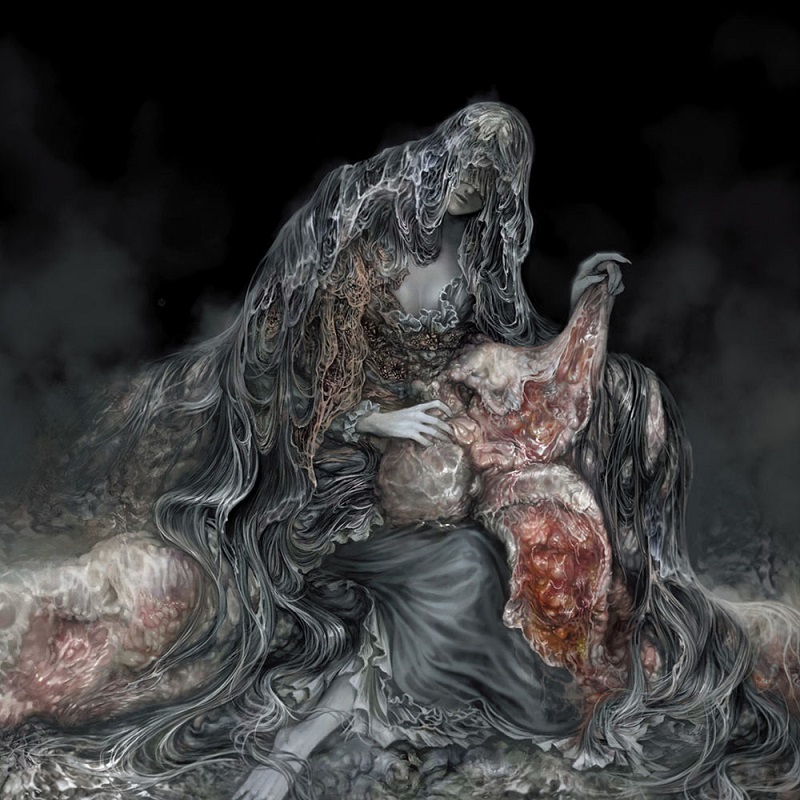 Her concept art makes it more apparent that the child she cradles is continually growing out of her, simultaneously an eternal stillbirth and cancerous growth. A similar theme shows up in the Yharnam Stone dropped by Yharnam, Pthumerian Queen in Bloodborne, which is a calcified unborn fetus. 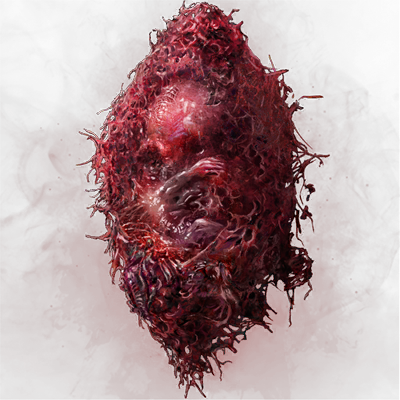 Some of you will ask, “so which is it, a stillbirth or a cancer?” The answer is “both.” In these games, the answer will always be “both.” We can even see these themes displayed in level design. Yahar’gul in Bloodborne is a frustration to many players due to Bell Maiden in the area creating continuous waves of respawning enemies until you kill them. This gameplay challenge is a metaphor for cancer cells reproducing continuously until they are terminated or they kill the host. In another example of dual meaning, the Amygdalas of the game most obviously plays off the center of fear in the brain known as the amygdala. But the second meaning is expressed in the Tonsil Stone we use to travel to the Nightmare Frontier and find the Amygdala boss: the role of being a bodily filtration system. Within Yahar’gul, the Amygdala are the filtration system of the organism being overwhelmed by the infinitely reproducing Bell Maidens. This explains their unusual sickly black appearance within Yahar’gul.  There’s also the case of Carim from Dark Souls. In the first game, Carim is a violent location that is mostly attached to the worship of Velka, the goddess of sin. But it’s also through Lautrec attached to worship of the goddess Fina. Without any explanation, Carim’s narrative changes in the third game, where it becomes a respected religious center dedicated to Caitha, the goddess of tears. One particular adherent to this religious order is an apostle named Morne. Morne's Great Hammer posted:Great Hammer bestowed upon Carim Knights who demonstrate outstanding strength and unwavering faith. Morne. Mourn. Carim is grieving both with and for their goddess of tears. What we know most about Caitha is sourced from the Red and Blue Tearstone Rings, which in Dark Souls 2 provide the first references to Caitha in the series. In Dark Souls 2, the emotional association of these rings is not unified. quote:Caitha, goddess of tears, mourns the undeserving dead, shedding tears as red as blood. Red could be said to imply a sense of anger and vengeance whereas blue is simply grief. But in 3, the emotional representation becomes unified. quote:Red: This stone is said to be a tear of mourning of the goddess Caitha, and of course, tears are always more beautiful near death.  Since I am here to chronicle the memory of someone for posterity, surely I can identify them? Well, no...but possibly yes. It’s convoluted. For a while I thought it was Takeshi Kajii who produced the original Demon’s Souls and was commemorated in the announcement of the Demon’s Souls Remake: quote:Our only regret is that our friend and colleague Takeshi Kajii, who was the original producer on Demon’s Souls at JAPAN Studio, is no longer with us to share in this moment. We hope we have done him and his legacy proud. My understanding is a tweet chain suggests that he died around 2013. This would be shortly after the release of the Dark Souls: Prepare to Die Edition, which would be some delightfully dark humor. I’d appreciate someone doing that for me, anyway. Regardless of whether the Prepare to Die connection is correct, ultimately I don’t think this is the individual I’m searching for. The temperament I suspect to find is something closer to the Lingering Flame description of Straid: quote:Straid was an oddly gifted mage, well-versed in both sorceries and pyromancies, but his curious temperament never allowed him to settle down in one place for very long. And I can’t imagine a person like having the mental fortitude to work as the producer for... ::checks notes:: ....WCW vs NWO World Tour. Kajii might roughly correspond to Laurence though. What I am certain of is that during the development of these games was deeply respectful of the wishes of all the contributors, even those who couldn’t make it to the end. Take this quick, offhand comment from a Miyazaki interview on the Game no Shokutaku podcast: quote:Murohashi: I would say that the Dark Souls character creation wins a 120% from Demon's Souls character creation, though! Rather than trying to identify the central creator via triangulating through the credits, it’s a lot more productive to figure out who they were inside the game and work our way out. Think of it as an anthropological study of someone’s OC self inserts. And by the way, gently caress you, Dark Souls, for making me conjure up that accursed sentence. Anyway, it’s super-obviously Seath https://i.imgur.com/UNhstgM.gifv
|
|
|
|
 One of the titles that came up when I was looking into the idea of video games as memorials was Zelda 2. It features an area known as the King’s Tomb, which serves no real gameplay purpose, nor any clear narrative purpose. Places like that in video games trigger a suspicion that there’s some especially important reason why they were included in the first place. But if Zelda 2 were a memorial to some individual, the real giveaway would be the peculiar changes between the Japanese version in January 1987 and the PAL release in September 1988. In particular, the water and lava in the overworld map stopped flowing in that the animation for those tiles was disabled. Sure, there could be a technical reason for this change, but it reminded me of the idea of stagnant water being a sign of uncleanliness and undeath that shows up in Sekiro. Hypothetically, the western release of Zelda 2 now lacking flowing water was a way of commemorating the loss of an individual who had been influential in keeping the creative waters flowing. With all that in mind, we have this extremely important quote from the Dark Souls 1 Design Works Interview: quote:Satake: Yes. From what I remember it was originally designed as a water temple. But as work on the game progressed, and the image of kindling and fire became more prominent, the water gradually dried up. Haha. There’s missing water everywhere in these games. From Dark Souls 1 to Sekiro, there are so many locations that are implied to have once had flowing water and now do not. At first I thought this just reflected technical limitations like frame-rate issues becoming part of the world building. But then I found out that the Demon’s Souls Remake changed the visual design of the Archstones Nodes from a blue-green glow to a smouldering fiery red. This is an invocation of the idea of the watery feel of the Nodes drying up and the image of kindling and fire becoming more prominent. So let’s reverse engineer the metaphor that was so important that it had to be completed in a remake a decade later. Seath represented the individual who was the creative force behind these games. The person who brought the waters of life to the world. Sometime during the development process of Demon’s Souls, Dark Souls 1 and possibly 2, this individual died. Unable to complete the original design without them, the concept of the game shifted away from expressing the now forever lost idea of this world into becoming a funeral pyre in their memory. https://i.imgur.com/skUYOhh.gifv How can I be so sure of this interpretation? Well, for starters, the Divine Dragon in Sekiro is obviously the Seath equivalent of the game, complete with parallel universe Moonlight Greatsword. 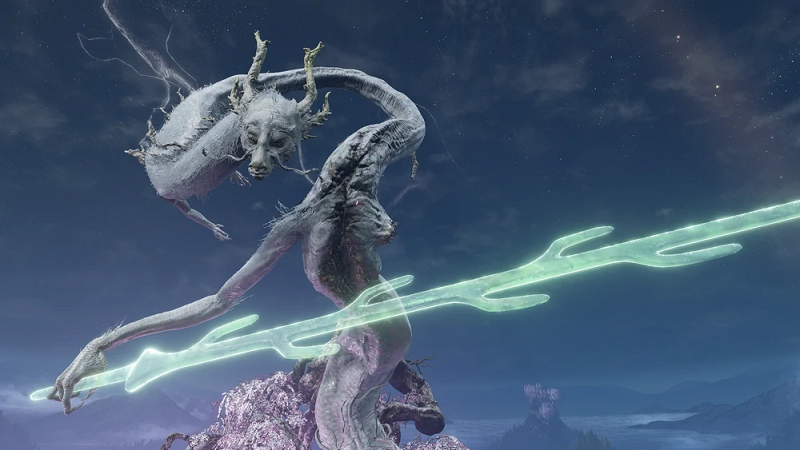 Within Sekiro, this dragon serves as the fountainhead for the dragonrot infested water bringing undeath into the world. In Dark Souls 1, we receive the Moonlight Greatsword by cutting off Seath’s tail. This is likely a play on the Sword of Moonlight: King's Field Making Tool that FromSoft sold to the public for modding purposes. Hypothetically, Sword of Moonlight was also the name for their internal development software, and Seath would have likely played a major role in its coding. Hence, receiving the Sword of Moonlight from Seath. This gets alluded to again in the phase transition cutscene of the Ludwig the Accursed fight in Bloodborne: https://i.imgur.com/s1FO5zO.gifv After the positively beastial first half of the fight, Ludwig regains a form of communicative sanity. This is one of the extremely rare examples of a Bloodborne fight becoming easier the further you go in the fight. This conveys the source of the beastial energy of the pair being gone, represented by phase 2 Ludwig no longer having a beast’s vulnerability to serrated weapons. This is also why Ludwig has two heads, with the non-speaking one lined with eyes, and the horse-head only gaining the ability to speak after the first phase. 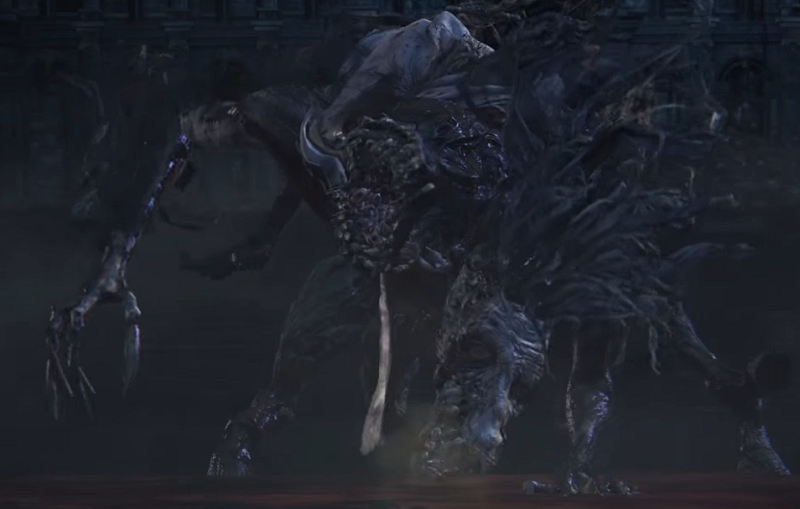 In phase two, Ludwig is full of a sense of reverence toward the Sword of Moonlight he now possesses, the last remaining memory of his former companion. quote:Aah, you were at my side, all along. Executioner's Chariot, DS2 posted:The chariot was created only to torment Undead, and it took the form of a horrendous mad steed, a window into the soul of its master. Little does he know that is not by his own will that he slays the Undead, but that of his horse.  Big Hat Logan, DS1 posted:The tomes stored in these Archives are truly magnificent. A great pool of knowledge, the fruits of superior wisdom and an unquenchable desire for the truth. Some would say Seath had an unsound fixation... But his work is a beautiful, invaluable resource. All progress demands sacrifice. And I certainly bear no antipathy for that wonderful scaleless beast. As I’ve mentioned, water is missing everywhere in these games, and one of the most prominent of these is Seath’s Crystal Cave in Dark Souls 1: 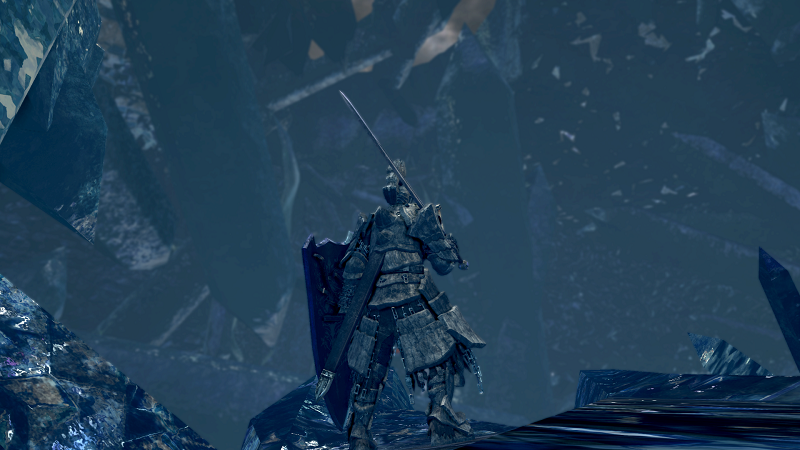 It’s most obviously a reference to Merlin’s Crystal Cave of Arthurian Myth. But more interestingly for us right now, the visuals of the area are based off of the Cave of the Crystals in Naica Mexico.  The Cave of the Crystals was, in a sense, uncovered twice. An upper level of the cave known as the Cave of Swords was discovered by miners in 1910. It features smaller crystals, speculated to be small either due to a state of relative immaturity or lack of heat and water. In 2000, miners uncovered the Giant Crystal Cave after draining water from the area during mining operations. I believe that the Crystal Cave used to be flooded. Seath’s lack of scales isn’t a defect, even if some both in and out of universe would treat it as one. Lacking scales is the perfect adaptation for an aquatic dragon. We even are shown this alternative, still watery realm in Darkroot Basin, where we fight the Hydra and encounter Seath’s Crystal Golems on a slope similar to the one in the Duke’s Archives that leads to the crystal cave. We find out in the Dark Souls 1 DLC that Darkroot Garden and its Basin were once known as the kingdom of Oolacile, lost to the abyss. The curiously obscure quest to enter the DLC begins here in the Basin, where we enter a cave behind the Hydra to rescue Dusk. Having done that, we can find a Crystal Golem in the Duke’s Archive with the Broken Pendant that allows us to be gripped into Oolacile. The thing about all this is that Oolacile is almost certainly cut content. In the Game No Shokutaku Interview, Miyazaki describes Dusk prior to the release of the DLC: quote:There was a removed event in early development where you would get summoned to Dusk's world. Her story was that she came from Oolacile, so there was a quest to rescue her in that kingdom after being summoned. We scrapped that quickly, though, "there's no way we can do that!" I wanted to make the old forest bright, and restore the ruins and buildings. So there you would do some quests in Oolacile, getting summoned by Dusk. It's sad, because she's a character I liked so much, so I was thinking about events and quests related to her. The scope of what’s described here, the idea of revitalizing a forest and restoring its ruins, is far too technologically intensive and deeply out of scope for it to have been a mere side quest removed from the Dark Souls we know. It represents a completely different direction for the game that was abandoned at some point. Almost certainly the point when the water gradually dried up, and the image of fire and kindling became more prominent. The ruins we find throughout Darkroot are leftover from the original prototype, preserved for posterity. I suspect that Oolacile was Seath’s baby. Once it became apparent that the illness was terminal in a sooner rather than later way, well...the water stopped flowing and the image of fire and kindling became more prominent. Dark Souls is in some way an incomplete game.  Dusk of Oolacile posted:I still think on that creature from the Abyss that preyed on me. In the Dark Souls opening, we see a shot of Seath’s bloody hand holding what we presume to be the scale of betrayed kin: https://i.imgur.com/fIFFeuR.gifv Forget about reading the myth literally a second. Suppose that Seath is so bloody in this scene because they have been peeling the scales off of themselves. How is the Scaleless one pulling off their own scales? Because that’s not a scale; it’s petrification. The spread of the curse. During the fight, Seath breathes a curse-inflicting mist on us. In the boss room are multiple petrified individuals, a fate the player will share if the curse build-up gets too great.  Outside of Seath’s chamber are Man-Eater Shells, which drop Purging Stones, an item that “does not dispel curses,” but only reduces curse build-up. A convenient nearby farm for a cursed being desperately trying to buy a little more time. Seath is sick. The Purging Stones are medical interventions, akin to chemotherapy. The abyss that claimed Oolacile was death itself. And during the course of the fight, when we destroy the “Primordial Crystal” that grants Seath a special form of immortality, on a symbolic level what we’re doing is taking Seath off life support. https://i.imgur.com/axlw5M8.gifv The Emerald Herald posted:This castle is isolated. But nonetheless, you must forge on. To bring an end to your journey…and mine. End your journey…and mine.  One game later, Brightstone Cove Tseldora provides us a fascinating echo to Seath’s Crystal Cave because it completes the historical metaphor. Despite being described as a cove, it is completely absent of water. And just like the Cave of the Crystals in Mexico, the area is the scene of a mining operation. https://i.imgur.com/g98hcba.gifv But first we need to start in the zone that precedes this, the Doors of Pharros. My first question is what is the creative etymology of “Pharros.” Pharis, the forest archer from Darkroot Forest comes to mind immediately. There is also the island of Pharos where the [url=https://en.wikipedia.org/wiki/Lighthouse_of_AlexandriaLighthouse of Alexandria[/url] once existed which has now sunk into the ocean, which is evocative of the sinking lighthouse of Heide’s Tower of Flame, earlier in the game. 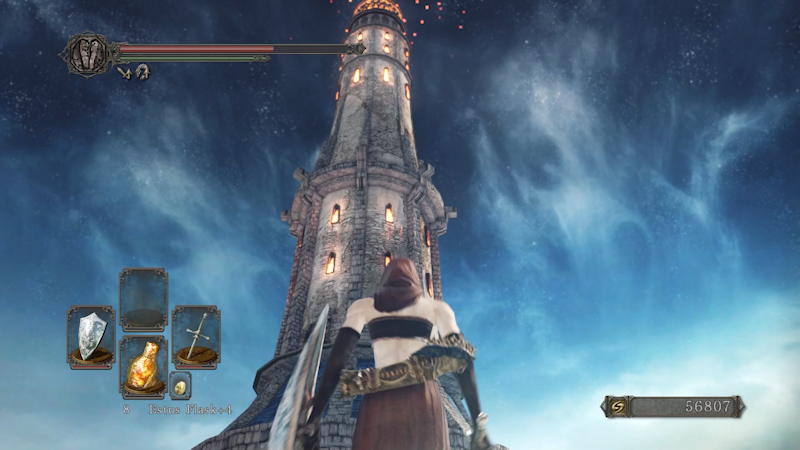 We also have the possibility of the Fungi from Yuggoth, where the Elder Pharos is a tower of stone that emits blue rays and is home of the last elder one, which is extremely evocative of the Nightmare of Mensis in Bloodborne. 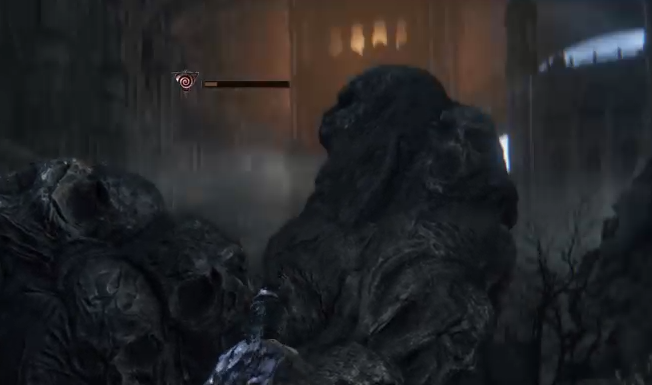 I kinda suspect all of them are true, but more simply I want to focus on Pharros being a corruption of Pharaohs, famous to us for their grand mausoleums. Because that’s what the Doors of Pharros are. A mausoleum of the dreams the Pharaoh was buried with. 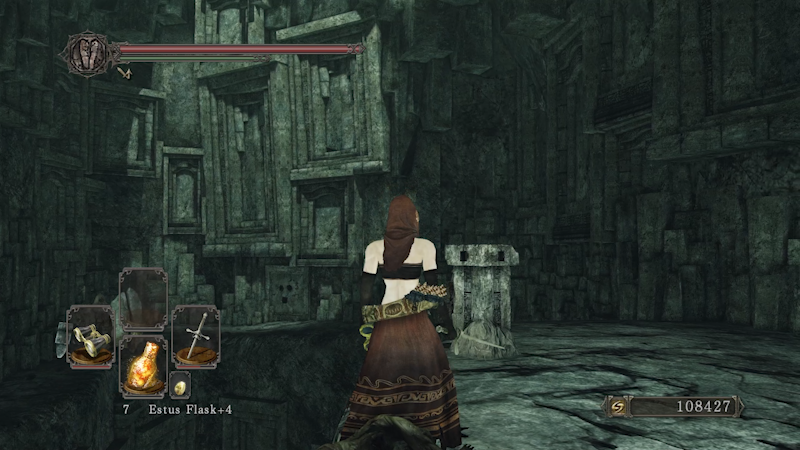 It’s most clear in the smaller ones here, but they are petrified mirrors. In both the Micolash fight in Bloodborne and the Looking Glass Knight fight later in DS2, mirrors are the gateways to other worlds both for personal transportation and for summoning. https://i.imgur.com/E7TaSAH.gifv An array of dreams and memories of countless alien worlds. And like the pillars in Ash Lake they are petrified. Lost to us. Buried with their creator because the curse took hold and the water stopped flowing. 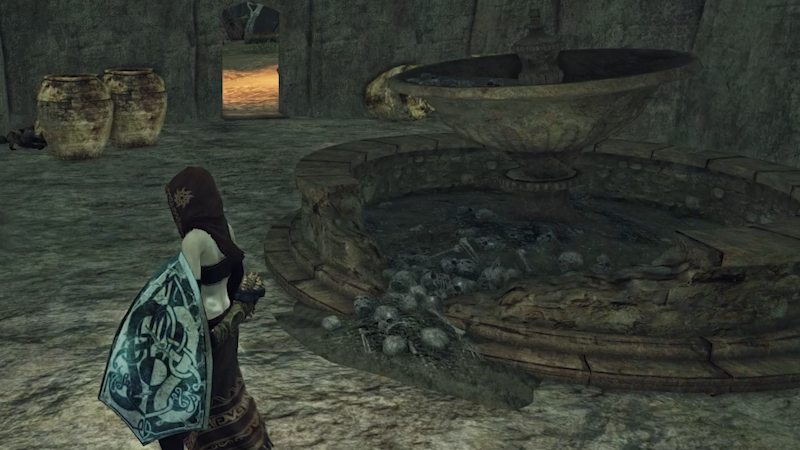 The followers didn’t give up. Instead of harvesting the fertile lands of Oolacile, they mined the petrified remnants of the cove. https://i.imgur.com/yUw2Q2l.gifv This shift from agriculture is DS2’s echo of DS1’s shift from water to fire, and is expressed in the description of the Hollow Peasant Attire: quote:Attire commonly worn by peasants. Note that there is no imagery of farming to be found in Dark Souls 2. The only place in the series that anything approaching farming imagery shows up is Oolacile’s Royal Wood:  The kingdom forever lost to the abyss. And who lies buried at the base of the Tseldora? 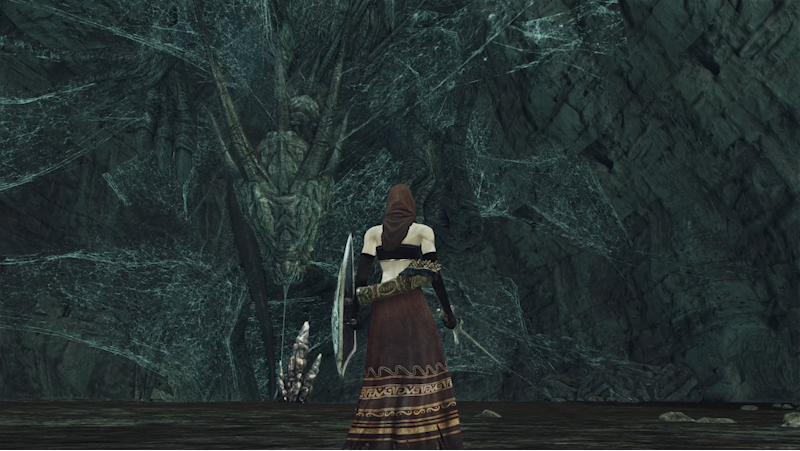 Old Paledrake Soul, DS2 posted:Soul of the ineffable Moonlight Greatsword, DS2 posted:The blade of this greatsword shines like the brilliant rays of the moon. In the oldest legends, rarely spoken of today, it is said that the sword was born of a great white being. In retrospect, it’s all fairly obvious, isn’t it? I’d also like to contrast this with the BlueMoon Greatsword we can inherit from Benhart of Jugo: quote:The Blade of this greatsword shines like the brilliant rays of the moon. In the oldest legends, rarely spoken of today, it is said that the sword was born of a great white being. “There must have been some mistake…” See? The world itself is in mourning for the magnificent souls that are now lifeless. Now for the fun part. The easy interpretation here is that the spiders throughout Tseldora have somehow caught Seath in their web and are gradually consuming the remaining essence. This interpretation isn’t precisely wrong, but it is incomplete. Dark Souls is a universe full of delightfully devilish double meanings. In tracking the origin for the concept of the Painted World, I came across a young adult book from the early 90s called The Ghost in the Big Brass Bed by Bruce Coville. In it, a ghostly artist left a painting called “Early Harvest” that depicted a scene from World War I so vividly that the main character gets forcibly pulled in: quote:It didn’t seem like the kind of situation where we were going to learn anything. So when Chris made a gesture with her head, I was glad to follow her over to look at the painting that hung above the fireplace. In the story there is a search for a Lost Masterpiece, the final creation of the ghostly painter who painted “Early Harvest.” The big reveal is that the entire house is the Lost Masterpiece, a grand mural covered up until the climax of the story. quote:You could feel the power swirling around Cornelius as he used his ghostly abilities to strip the aging paper from the walls and bind it around Carla. This is Dark Souls. Something terrible; something wonderful. Magnificent. Terrible but beautiful. Part of the book’s twist is that the painter had lost both legs and was incapable of painting it on their own. So a soldier they had saved had helped them finish it. quote:“Then there were the ropes we found in the attic. Too many ropes for a simple hanging.” The spiders of Tseldora are rigging Seath up so the paledrake can finish painting. Through both sickness and through death. A once magnificent soul continuing to exert influence over the land, even after the eons have reduced it to these remnants. The Undeath of the Author. Ancient Dragon Soul posted:Soul of the great ancient dragon that stands magnificently, deep within the shrine. Create something of great worth? I can only promise that I will try, but I am but a humble tomb prospector. Albeit one who has peered into the essence of this particular soul for a very long time.  The question remains: how can I be so certain that an individual so magnificent somehow remained hidden? Well, let’s start with George R.R. Martin and Elden Ring: quote:“The actual collaboration itself begun with Mr. Martin ever so politely confirming what sorts of themes, ideas as well as many game-related aspects I had envisioned for the game,” Miyazaki said. “This allowed us to have many free and creative conversations regarding the game, in which Mr. Martin later used as a base to write the overarching mythos for the game world itself.” It’s a surprisingly drastic change in narrative design. Unless you assume that it’s not. That there’s always been someone writing the overarching mythos that forms the base of the game that is then interpreted by the scenario writers and area designers. quote:“Storytelling in video games – at least the way we do it at FromSoftware – comes with a lot of restrictions for the writer,” Miyazaki told IGN. “I didn’t think it was a good idea to have Martin write within those restrictions. By having him write about a time the player isn’t directly involved in, he is free to unleash his creativity in the way he likes.” A set of writers who have substantial restrictions, and an author who exists outside these restrictions from whose mythos the world is built. It would make a lot of sense that FromSoft has used this technique for a long time, and would explain how their works have had such a deep thematic continuity over decades despite numerous changes in visible leadership. But it does require that there was an invisible leader this whole time. It also necessitates a reason why they now need a replacement. As I quoted at the beginning, the Emerald Herald tells us to “seek those whose names are unutterable, the four endowed with immense souls.” Namelessness shows up a lot in this series. The Nameless King of Dark Souls 3’s Archdragon Peak. Even the closing credit music for Dark Souls 1 is titled “Nameless Song.” That’s certainly not referring to Gwyn. It’s referring to the other individual in the kiln: the first flame. I’ve talked elsewhere about how both Bloodborne and Dark Souls 3 describe a history of ceremonial burial combined with economically driven desecration, but I want to focus more specifically on the idea of the bonfire itself. Bonfire derives etymologically from the phrase “bone fire,” and their spiritual significance was to be a place of honoring loved ones and driving away evil spirits. Both of these ideas are potentially invoked by the Clockwise and Anticlockwise Metamorphosis runes in Bloodborne. If what we’re playing off of here is Gaelic pagan traditions, these concepts correspond to the Deosil (clockwise) and Widdershins (counter-clockwise). In rituals the Deosil motion is meant to attract desired energies and the Widdershins is meant to banish or dispel harmful ones. Communicating with the dead and banishing the strife and sins that still haunt them. The Sacred and the Profane, Mircea Eliade posted:By the erection of a fire altar Agni is made present, and communication with the world of the gods is ensured; the space of the altar becomes a sacred space This idea of rotation shows up more often than you would think. Aldrich’s tomb in the Cathedral of the Deep is visually inspired by the Kaaba, the most sacred site in Islam. 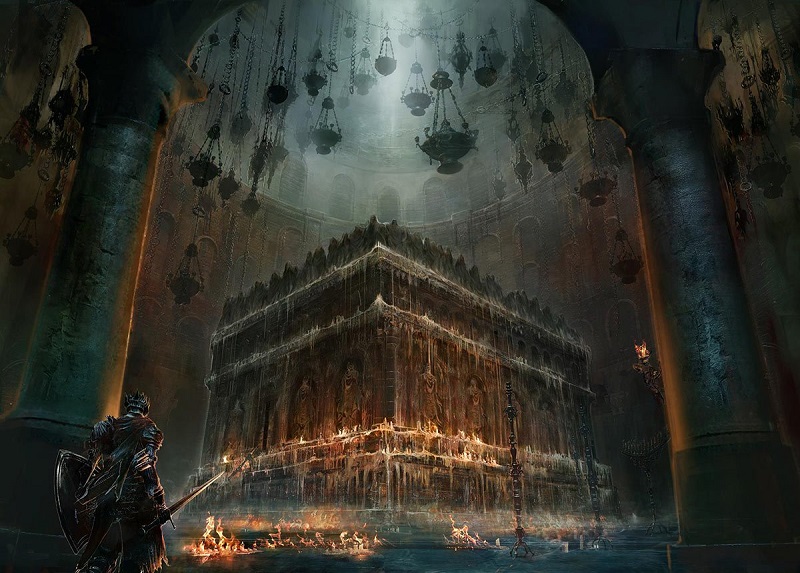 It’s a location where pilgrims travel to participate in a ritual described as circumambulation, the act of moving around a sacred object or idol. This act “is believed to demonstrate the unity of the believers in the worship of the One God.” And it’s the ritual the Silver Knight ghosts are engaging in at the threshold to entering the Kiln of the First Flame in Dark Souls 1. https://i.imgur.com/CuI27EU.gifv But as always, there’s multiple layers to the metaphor. This entrance both evokes and invokes the humanity sprite, which is a silhouette of an individual. A sign that someone was there without revealing their identity. 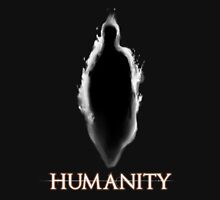 And this same concept shows up in the original Dark Souls 1 cover art.  quote:Nakamura: Your proximity to the darkness and the impending sense of dread and anticipation, we tried to capture all that in the design. This cover portrays an individual who we cannot recognize and would not even notice was there if not for the way they conceal a portion of the light. Whose absence creates a tragic eclipse for which the world mourns. 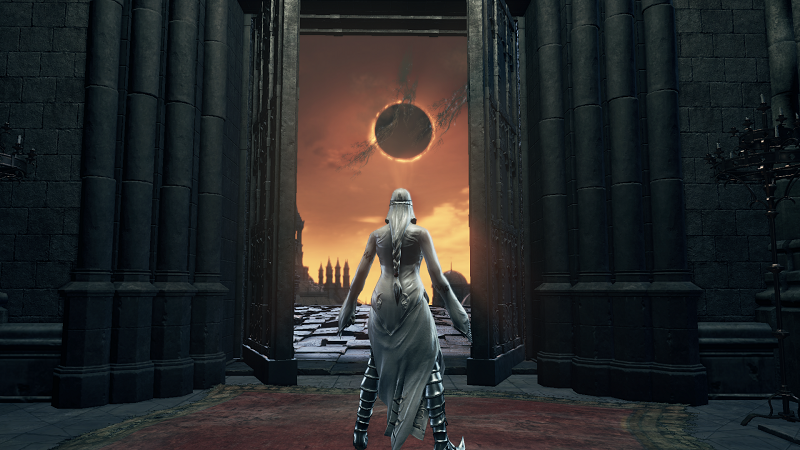 The other metaphor we can use here is of a star we cannot see, but who we can detect because their gravitation field is so immense that we can measure the peculiar way in which light bends and reverse engineer their existence and position through the findings. That’s effectively what I am doing in this project. This also leads to the other meaning to the rotational imagery in the Kiln of the First Flame. It’s the gravitational center of this universe. Its Dark Sun. The Dark Sol.  Storyteller's Staff (DS3) posted:Staff of a heretic storyteller who shares tales of the Painted World to forlorn souls. There’s one other use of bonfire that is now important to remember: a bonfire of the vanities. In Italian history it is the burning of objects condemned by religious authorities as occasions of sin. Certainly something that might be done to the tomes left behind by a heretic storyteller. And so we run into the final reason I believe why this magnificent heretic’s soul remains a nameless one: because they were transgender. A pharoah can be interpreted--be understood by the objects they choose to be buried with, and this series screams reproductive dysphoria at every single opportunity. From Bloodborne’s obsession with stillbirths and surrogates, depicted most vividly in the bloody dress of Queen Yharnam 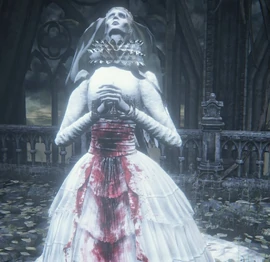 And most poignantly in the cracked egg of Filianore. 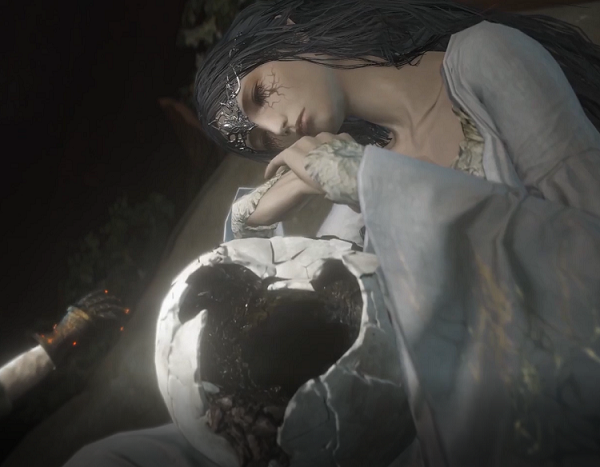 The Moon Presence presents another depiction of a barren Fisher Queen. 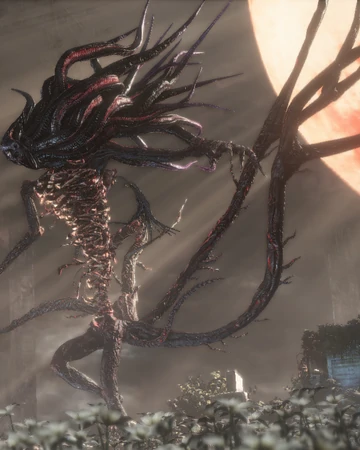 And if we extend this theme, the Throne of Want in DS2 represents Nashandra’s desire for the yonic. 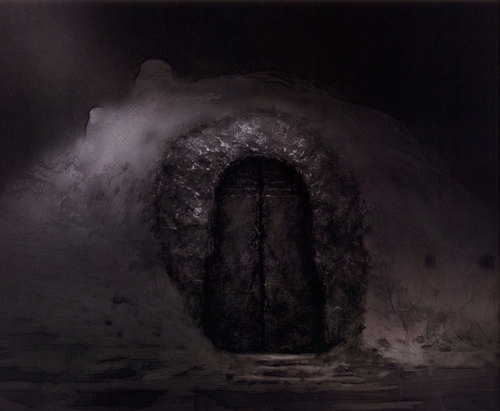 And of course, the Bed of Chaos is an artificial uterus. The end of the first phase of the Curse-rotted Greatwood is triggered by a castration. https://i.imgur.com/EVBOEE1.gifv Seath’s concept art even depicts what is pretty obviously pregnancy once you become attuned to the symbolic pattern:  Then we have dialogues such as this one: Cornyx of the Great Swamp posted:Ahh, what have we here... Anri of Astora is a mechanically non-binary individual in that their gender changes in accordance with the socially acceptable complement to the player’s. They’re also kinda getting a funeral service. 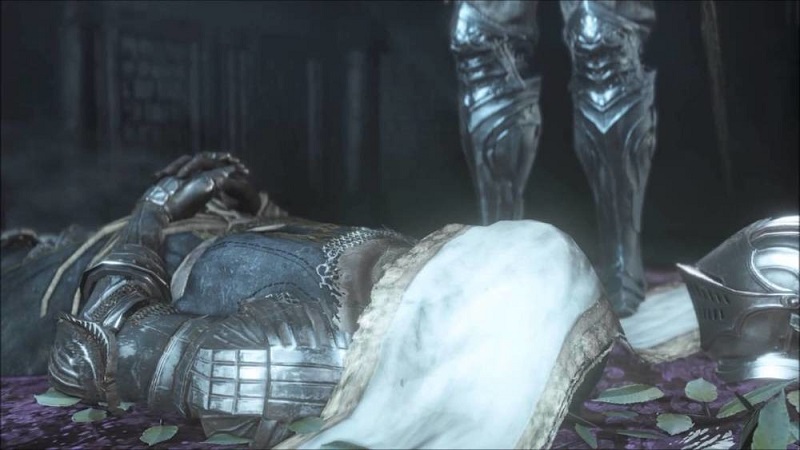 We also have DS2’s Coffin of Gender Change and DS3’s Reversal Ring. quote:A divine ring granted to the Darkmoon Gwyndolin in his youth. And that brings us to Gwyndolin. We know that Gwyndolin has some kind of attachment to Seath due to the fact that she shares a musical theme with the Moonlight Butterfly, like the ones we find in Seath’s Crystal Cave. We also know that they, like Seath, seem to be dead. I mean, why else would we need a Darkmoon Seance Ring to contact her? Seance has a very particular meaning. And people will tell me that we know that she is a he, but they’re simply not capable of reading the subtext of what’s going on. I have read people’s complaints that FromSoft describes Gwyndolin very negatively in the first game, but that’s not what is being expressed. The Darkmoon Blade Covenant Ring tells us: quote:Gwyndolin, all too aware of his repulsive, frail appearance, created the illusion of a sister Gwynevere, who helps him guard over Anor Londo. An unmasking of these deities would be tantamount to blasphemy. “Repulsive, frail appearance” is a self description, and to deal with this self-loathing Gwyndolin has created a fictional alter ego to exist in her stead. You don’t say use the indefinite article ‘a’ when referring to an actually existing individual. Creating a pseudonym to play as a way to deal with disgust at your own appearance is classic gender dysphoria. And yes, I’m performing an unmasking here, but what’s a little blasphemy between sisters? If we’re talking about an author hiding behind a seemingly infinite series of pseudonyms, it becomes highly relevant that FromSoft’s Soulsborne/Sekiro follow-up, Déraciné, is described as being influenced by the Scottish author writer Fiona Macleod, or as google deadnames them William Sharp. I mean, technically, at this point all of their names are deadnames. No, I can’t say with any absolute certainty that Fiona/William was trans, but I can point out that despite the majority of their most influential and memorial works being written under Fiona, it’s weird that there’s a strange insistence to make sure they’re credited as Sharp at all times. We don’t go around getting huffy that people aren’t upset about the erasure of Samuel Clemens. In any case, Fiona’s personal letters read like a 1890’s version of r/egg_irl posts, and Fiona is the name cited by Miyazaki himself when discussing Déraciné. Darkroot Garden even has the hunter Pharis whose identified gender shifts back and forth over the course of the series, and etymologically could derive from “Pharais and the Mountain Lovers,” one of Ms. Macleod’s most famous novels. “Gwendolyn” is also a name heavily associated with the Gaelic Revival tradition that Fiona Macleod’s works were a major part of. Given all of this, the reason an author who stayed anonymous for the entirety of their career was so heavily invested in the works of Fiona Macleod is an unusually transparent one for a game that is normally quite convoluted. Dark Souls is a story about purifying a tragic, twisted soul. A wondrous being tormented by strife. A story of metamorphosis, of ascension, of transition. This is why we see the same character area motifs show up repeatedly. They’re attempting to evolve. Gwyndolin to Alsanna, to Lothric and Aldrich. Aldrich’s bottom half is a morass of death, but it also represents a cocoon. An aspiration of emerging again one day as a moonlight butterfly. https://i.imgur.com/1Mn0dYh.gifv Both Friede and the Painting Woman represent Seath, with Friede representing a lifetime of rage and frustration and loss fueling her to cling onto a dead, decaying world. quote:Be forewarned, eager Ash, We aren’t killing Friede; we’re freeing her from strife. We’re letting her soul finally rest, so she can move on. So the Painting Woman can take over. When you complete the Ringed City, you can bring the Painting Woman the Blood of the Dark Soul. In response, she asks you your name. If you answer “I have no name,” she responds, quote:I see. We are much alike. Yes, I suppose we are. I seem to have a deep affinity for the nameless. I believe the Painting Woman is the final form of Gwyndolin. A denizen of a peaceful, accepting world where she no longer needs a mask, where can do the thing she wanted more in the world: preparing the womb that is her Painted World: quote:I will assuredly finish the painting. To return to The Ghost in the Big Brass Bed, it ends on the same of the undead painter finally being able to find peace: quote:“As I followed them with my eyes, they came to a place beside the door, and I realized that I had been wrong; Cornelius Fletcher’s painting was not complete.” https://i.imgur.com/8RwwAjc.gifv Except Dark Souls is in some ways an incomplete game, and I think that’s what Seath would have wanted: to spiral on for all eternity. Only now they’re able to paint a peaceful world for the individual they cherished most. To whom they dedicated their entire life. quote:Ashen one, I cannot die. I am compelled to serve as their hunter of hunters. An outsider from the Hinterlands here to perform a sky burial so that they may return to the skies and find a place of rest in our dreams. Their story has become indescribably precious to me, and so I will attempt to tend to their flame. There is so much more to tell. So much more depth to delve into the most fantastic soul I have ever encountered. More terrible and more wonderful than I imagined a soul could ever be. For now though, I can admit that I look through a glass darkly. I may never be able to precisely identify the First Sin. But I can say with all confidence that the true sin would be forgetting. https://i.imgur.com/t4jCKbZ.gifv Déraciné intro posted:Aren’t you excited? You’re going to be a fairy and live in the world where time stands still, when nobody can see what you’re up to ever again. quote:The word déraciné means to be uprooted or describe a person who has been displaced. quote:The Last Fay by Fiona Macleod 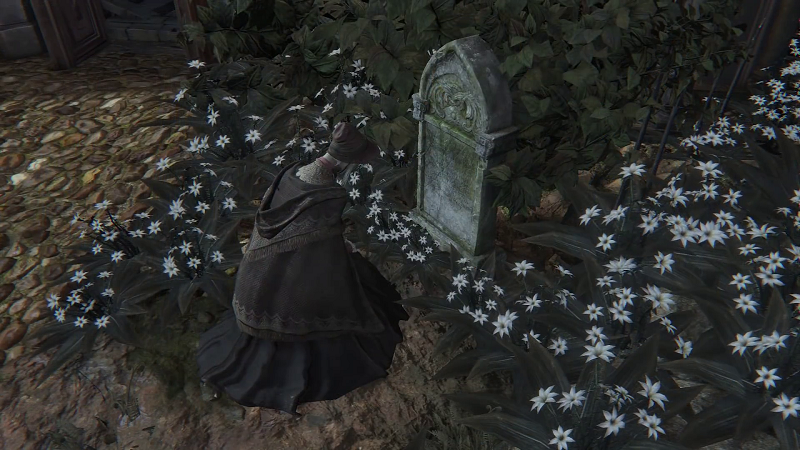
Sibyl Disobedience fucked around with this message at 06:54 on May 25, 2021 |
|
|
|
Um. Okay. Wow. When you spell things out like that and put everything together... I am transgender myself, and I am also a multi-time cancer survivor so um...wow. This whole update has me thinking all kinds of thoughts and kind of has my mind in a complete state of shock right now? I need some time to think about all of this and try to straighten my thoughts into something legible, but...yeah. I'll be coming back to this once I'm able to make sense of how I'm feeling right now. Good update. This is a good, good thread.
|
|
|
|
Vandar posted:Good update. This is a good, good thread.
|
|
|
|
My thanks to both of you, as well as everyone else who has been reading along. Your continued presences have been a tremendous help. The degree to which I've come to find myself connected to this is almost a little frightening. I think I can track this person through 4 decades worth of video games, and if even a fraction of my suspicions are correct, they're far and away the most influential person in my entire life without me ever having a sense that they actually existed. And they were brilliant. Even Dark Souls alone is an absolute semiotic masterpiece. Even if I can't explain it yet, I see the shape of how it was conceived and am in a perpetual state of absolute reverence. Now I just need to brave the terrifying ordeal of being seen, because the world needs to know about her. Maybe I should even reboot the thread, now that the ashen mist has cleared some. I could even actually play Demon's Souls.
|
|
|
|
Whoa, didn't expect that. Some of the connections seem tenuous but it's a beautiful story nonetheless.
|
|
|
|
|
This thread fuckin rules. 
|
|
|
|
I just wanted to chime in after finding this via the crosspost in the trans thread. I almost overwhelmed at all this work and it really resonates with me, I guess I’m just very grateful for what seems like an exhaustive/exhausting deep dive into a series that’s always meant a lot to me, and how it looks gazing through a trans lens at it was the last thing I expected, so thank you very much for all of this.
|
|
|
|
Peacoffee posted:I just wanted to chime in after finding this via the crosspost in the trans thread. I almost overwhelmed at all this work and it really resonates with me, I guess I’m just very grateful for what seems like an exhaustive/exhausting deep dive into a series that’s always meant a lot to me, and how it looks gazing through a trans lens at it was the last thing I expected, so thank you very much for all of this. Can I get a link to that thread, if you don't mind?
|
|
|
|
Vandar posted:Can I get a link to that thread, if you don't mind? Of course! https://forums.somethingawful.com/showthread.php?threadid=3906197
|
|
|
|
anilEhilated posted:Whoa, didn't expect that. Some of the connections seem tenuous but it's a beautiful story nonetheless. If it makes you feel any better, neither did I when I started this thread! As for tenuous connections, that's a real thing. In the background, I'm constantly weighing whether to include certain things that might be a connection or might just be random noise. In a way I'd like to bring them all up so that people's reactions could help me sift through it, but I know that doing so will make a lot of people tune out completely, so I try to focus on the chains that I think are the strongest. Even doing that, there's a lot of things in here that I wouldn't feel a sense of certainty about if it were not for the fact that parallel sources seem to support them. Like "primordial crystal = life support" isn't an especially proven symbolic link, but the idea ends up going places once some future stuff gets brought into the mix. I'm thinking of doing a post this weekend about the concepts of semiotics and translation and how they relate to Dark Souls, which I know probably sounds dry as hell, but I think the games serve as a wonderful playground for what often inaccessible philosophical wankfests but actually contains really important ideas about how we preserve meaning and communicate it to one another. Pollyanna posted:This thread fuckin rules. Peacoffee posted:I just wanted to chime in after finding this via the crosspost in the trans thread. I almost overwhelmed at all this work and it really resonates with me, I guess I’m just very grateful for what seems like an exhaustive/exhausting deep dive into a series that’s always meant a lot to me, and how it looks gazing through a trans lens at it was the last thing I expected, so thank you very much for all of this. Thank you both! There's so much more to come too. I just completely out of character binged on the latest Steam sale in order to procure more research materials. And that includes actually getting NieR Replicant at full price. Oh the places this will go...
|
|
|
|
Sibyl Disobedience posted:I'm thinking of doing a post this weekend about the concepts of semiotics and translation and how they relate to Dark Souls edit: Just to avoid any misunderstanding, I'm completely unironically looking forward to that; this is the only analysis I've yet encountered that really takes these games seriously as works of art (by which I mean that the analysis actually follows through on that and doesn't just state that they're profound or moving in some vague way), and I'm beyond delighted about it. Carpator Diei fucked around with this message at 21:32 on Apr 29, 2021 |
|
|
|
So, I was thinking about the arguments for Gwyndolin being a transwoman, and my thoughts shifted to looking for arguments for the opposite. That is Gwyndolin being transmale. We do not actually even know if the gods have biological genders. They are generally described as having only one parent each and nobody ever wonders who the mothergoddess to the magnificent father could be. This means that "Gwyndolin was raised like a daughter" could be taken more like the "he used to be a woman" that used to be a default phrasing identifying a transman in Japanese. Gwynevere is not being controlled by Gwyndolin, the illusion continues working after you kill Gwyndolin. This moves her from being a idealized selfpresentation of a transwoman to being the pornographic creation of a male artist. Gwyndolin, all too aware of his repulsive, frail appearance: The frailness that triggers Gwyndolin's disphoria is generally considered feminine. When item descriptions are trying to mislead the player, they are doing so in service of the gods' agenda. As Gwyndolin is the only living god during the game, it would be strange for him to be misgendered by them. What do you people think?
|
|
|
|
Well, this has hijacked my thoughts in a very important way, so I'm going to delay the other post a bit to address it. Because visibility is important, and when it comes to visibility, some forms of transness receive more of it than others, both for better and for worse. Dark Souls has -a lot- of gender non-conforming characters, which is part of what made me suspicious that gender identity was playing a bigger role in the series than I had originally conceived. And one of the genuinely really cool things about them is that a lot of the narratives can be read both ways. Gwyndolin is an example of this, but there's also Lucatiel. In the most obvious read, their implied story is very Mulan-esque. Wants to be taken seriously as a warrior and live up to brother. Disguises self as male in order to become a knight and rise up within the hierarchy of Mirrah society. Simple and straightforward. But you can also read a transfemme story into Lucatiel. The mask is kinda pathetic. It seems to fool people, but there's not a ton of pride kept into its upkeep. Nevertheless, they hold on to this projection of a false self in order to not lose this status of knighthood and the accomplishments revolving around it, which is just as integral part of their identity as their gender expression. In this light, Lucatiel's plight is a choice between giving up an authentic expression of self or giving up societal privledge, which is a real choice that transfeminine people often face. I think this is honestly really important. I've been a bit surprised that the people I find myself relating to most often in real life encounters are non-binary AFABs. Despite our trajectories being opposite, our general ideals of navigating gender are much more closely aligned than transfolk who fully adopt the gender binary. So characters like Gwyndolin, Lucatiel, Ciaran, all being relatable in both directions is a pretty amazing expression of this. But I've also come to believe that Dark Souls was intentionally written to be interpretable in two directions. That Demon's Souls Light Tendency and Dark Tendency are inherently baked into the world design. Basically like an M C Escher painting where both the foreground and background contain coherent images, and which one you see is entirely based on which one you're focusing on. If I'm right about this, then it's likely that Gwyndolin was canonically designed to be both transmasc and transfeminine. That they are a disguise for two separate souls going in two opposite directions. I have theories about how this series leaks into the real world. But some of these I don't share because they're still far too tenuous and might remain that way forever. Others I don't share because if I'm right they come too close to revealing something about an actually existing person that they did not decide to reveal. I may be willing to engage in blasphemy, but even I have my limits. With that caveat out of the way, one of the first things I did once coming up with the idea of GRRM being a replacement is trying to identify who he would be replacing. Seath is my answer now, but it's entirely possible that there was an individual between Seath and GRRM who may have been some variant of closeted transmasc and who also died unexpectedly during the creation of the games as well. If this were correct, then Gwyndolin might have been conceived as a composite memorial to both of them. And Gwynevere might have represented a societal ideal that they both felt a pressure to conform to and both to some extent loathed. I think either way, Rosaria definitely exists as a commentary on the iconography surrounding Gwynevere. That is as far as I'm comfortable revealing right now given the constraints I mentioned. I'm ultimately partial to the idea that Gwyndolin is a shared figure for trans people in both directions. If it seems like I only focus on one, part of that is probably a degree or personal bias, and partially just a simple aspect of Seath being the more direct progenitor of the series and therefore having an outsized influence. (I do want to add as an aside that if you're willing to see the games as an explanation of two different planes of reality simultaneously, then cause and effect becomes rather convoluted. Is Gwyndolin actually a living god? We can only contact them via a Seance ring. And thus, Gwynevere's presence maintaining without Gwyndolin is ultimately not a whole lot different than these games hypothetically only coming out after their creator had already died. The narratives that humans project often outlive the humans themselves.)
|
|
|
|
Sibyl Disobedience posted:(I do want to add as an aside that if you're willing to see the games as an explanation of two different planes of reality simultaneously, then cause and effect becomes rather convoluted. Is Gwyndolin actually a living god? We can only contact them via a Seance ring.
|
|
|
|
Carpator Diei posted:And this still assumes that Gwyndolin, Gwyn and their whole family actually are deities in any substantial sense. One of the most striking things about the gods of Dark Souls is that their only god-like attribute is the worship they receive; in terms of the information we get about them, they mostly act like very powerful humans. Granted, that's also how a lot of gods in real-life polytheistic religions act, but those gods tend to have had some mythical role in the creation of the world; the Dark Souls gods weren't involved in any of that, and there doesn't really seem to be a creation deity (unless you count the First Flame). At the very least, it's deliberately ambiguous whether the gods are actually different from the humans they rule over. On this point, it's also worth considering that Dark Souls may very well come out of a cultural trend in JRPGs to lean heavily on the traditions of Gnostic Christianity. quote:a prominent heretical movement of the 2nd-century Christian Church, partly of pre-Christian origin. Gnostic doctrine taught that the world was created and ruled by a lesser divinity, the demiurge, and that Christ was an emissary of the remote supreme divine being, esoteric knowledge (gnosis) of whom enabled the redemption of the human spirit. With all the talk, particularly within Bloodborne, of humanity wishing to ascend to godhood, become kin, etc., it's worth considering that the line between godhood and humanity in the world of Lordran is far more blurred than we would initially expect. Do Gwyn and Gwyndolin represent the demiurges who we must overthrow, or at they humans who claimed the First Flame in an attempt at enlightenment, and our journey to lay them to rest, of being the chosen undead, is us inheriting the tradition in order to take the next step towards becoming a better steward to a godless world that we've collectively inherited? The further I go, the more I lean towards the latter interpretation. I wasn't expecting it, but I've come to view both Seath and Gwyn as tragic figures who are sympathetic in nature.
|
|
|
|
At its core, Dark Souls is about the idea of preserving meaning in a dying world, and seeking a way to transfer that meaning to future generations. It's a theme that would resonate strongly with a dying creator desperately trying to preserve their unfinished stories. And developing the means to do it would be highly necessary for a heretic storyteller looking for ways to transfer their stories through the cultural filters and censors that stood in their way. And this brings us to the study of semiotics. I'm going to do everything in my power to not get dragged down into jargon. Semiotics is fundamentally a study into the multitude of ways meaning can be transferred. Rather than try to explain that with more stupid, useless words, I'd rather show you the classic example of semiotics in video game design. Seeing semiotics in action transfers the meaning far better than trying to talk about it. https://i.imgur.com/QnCYC3j.gifv For such a simple segment of gameplay, there is so much being conveyed here. First, before everything else, the designers of Metroid understood the cultural context they were entering. I've recently started a part-time job babysitting a toddler, and one of the first things we did together was play Super Metroid. Every time I came over she would cry out for "Space Mario." And that's the understanding people would have had playing Metroid for the first time. The problem is that Mario 1 is a very linear game. You go right. Occasionally special events allow you to go up (climbing vines) or down (entering pipes), and sometimes you can find special ways of going right (the warp zone at the end of 1-2) or need to find special ways of going right (8-4), but in the end the game is an obstacle course with a very singular direction. Metroid is not that. It's one of the pioneering games of non-linear exploration. But that leaves you, as the developer, the challenge of how to train players into realizing that they are allowed to explore in a non-linear fashion. That they're, in fact, expected to try going in every direction, and especially left. With that said, here's what is being conveyed in that ~15 second stretch of gameplay. 1. If you follow your Mario programming and go right, you hit a wall that definitively prevents further progress. 2. However, the wall has a small stretch of open space at the problem, prompting the fundamental philosophical quandary of human existence:  3. The possibility of escape is further suggested to you by the AI enemy's placement crawling through that same space before you can reach it. And even further highlighted by the unique tile shift surrounding the crawlspace. 4. So you eventually do the only thing left to you and go, well, left. 5. At this point, you might be reminded of the symmetry of the starting screen. Compare and contrast it to the starting screen of Mario 1.  Mario's left oriented starting position suggests to the player that you exist on the left-most edge of the world, and subsequently that your immediate goal is to head right. Samus, by contrast, is centered in a symmetrical structure, suggesting that both right and left are possible and subsequently important. 6. Once you go left you find a similar crawlspace structure to the one that blocked your path to the right, only this one has stairs built into it, giving you a means to escape. 7. In this room you find a ball, and you are now locked into this extremely small area until you learn to use that ball by pressing down and mimic the alien behavior that you first observed on the rightward dead end. 8. Which reminds you that you can now progress under that dead end and continue further into the game. This is such a classic sequence that if you play Metroidvania games made over three decades later, there's a very good chance some kind of secret will be found immediately to the left of your initial control point. It established the very language of teaching the player how to explore the world as conveyed entirely through visual and technical elements of the world design. So if we're interested in understanding the means by which video games tell their stories that exists outside of standard verbal communication, we essentially have to learn how to translate from one language into another. Think about the core magic system trinity of the Souls games: Sorcery, Miracle, Pyromancy. We have a sense that Pyromancy is derived from Sorcery: Yuria, the Witch (DeS) posted:Freke wields a different kind of magic from my witchcraft. But we also have a sense that Pyromancy is a sort of synthesis between Sorcery and Miracle. In DS2 and DS3 Pyromancy scales with both Intelligence and Faith, suggesting a blending of the two disciplines. Pyromancy also is the only art to eventually recreate healing Miracles in the form of DS3's Warmth spell. So if we were the designer who came up with these systems, what kind of allegorical framework might have served for the inspiration of these connections? One of my favorite ones is that it's a commentary on making video games. Sorcerers are the programmers. Clerics are the writers. These groups are regularly at each others throats over what can and cannot be accomplished, and what should and should not be prioritized. Pyromancers are those who straddle both worlds. They understand enough of both arts to understand where compromises can be made. Subsequently, they're the best people to figure out how to rethink the use of code to better tell the stories they have, or, alternatively, rethink the manner in which stories are told so that they better fit in the technical and financial constraints that the project operates within. But I think there's a reason so much of both Miracle in DS3 is learned through Braille Tomes. Because to properly practice those arts you need to feel. If the Intelligence stat is the strength of ones Intelligence, one could then see Faith as the strength of one's Empathy. The ability to tell better stories by understanding the feelings and emotions of the figures whose stories you're telling. That makes Pyromancy a mish-mash of the two. The capability of thinking critically about an entire network of feelings and being able to arrive at conclusions that neither a Sorcerer nor Cleric would ever discover on their own. Old Sage's Blindfold posted:Attire of pyromancers of the Great Swamp, particularly favored by old sages. This is the core of why both Dark Souls and Bloodborne so heavily play upon blinding one's self in order to achieve higher understanding. By not seeing the world in its most obvious framework, we can better understand the underlying connective language. We gain eyes on the inside. What I'm essentially doing in this entire thread is learning to read the braille tomes that form the foundation of this series. Most lore theorists focus entirely on what they see, and they can tell you a mostly tidy story of the narratives, albeit with huge portions of the game covered by a giant shrug emoji. I'm instead trying to feel my way through the forgotten side elements and piece together why they're even there. I had a suspicion that these things meant something to somebody, and I want to know what that meaning is...or was... In order to achieve this advanced form of empathy, what we need is an interpretive framework. A Rosetta Stone that gives us insight into the translation process. And for understanding what that would entail, I like to turn to the book Godel, Escher, Bach for inspiration on how to identify the isomorphisms that were undoubtedly used to make these games. quote:The word “isomorphism” applies when two complex structures can be mapped onto each other, in such a way that to each part of one structure there is a corresponding part in the other structure, where “corresponding” means that the two parts play similar roles in their respective structures. In a single item description, DS1 introduces the idea of the monomyth: Ricard's Rapier posted:A rapier with intricate decorations. Chosen weapon of the famous Undead Prince Ricard. Ricard's exploits are told in a monomyth. I think the Souls games are a giant experiment in creating a series of stories derived from the same monomyth that effectively serve as an isomorphism for each other. Which is loving fantastic. Like, I'm incapable of expressing the sheer excitement this idea elicits from my cold, dead heart. Kos...how grossly incandescent... Okay, so back on track. How do we track down an isomorphism? Unfortunately, there's a lot of trial and error: quote:When you confront a formal system you know nothing of, and if you hope to discover some hidden meaning in it, your problem is how to assign interpretations to its symbols in a meaningful way. In this case, the 'educated' part of my guesses come from trying to understand what sort of person would be playing around with this set of symbols in the first place. At it's core, this is an intellectually-oriented expression of empathy. Reverse engineering the type of soul that would fixate on these forms of theme and expression. And so I came to the conclusion that Seath is dead. If you read those posts and came out of them with a feeling of, "well, maybe she's onto something," then we have shared in this sort of experience: quote:It is a cause for joy when a mathematician discovers an isomorphism between two structures which he knows. It is often a “bolt from the blue” and a source of wonderment. The perception of an isomorphism between two structures is a significant advance in knowledge--and I claim that it is such perceptions of isomorphism which create meanings in the minds of people. What I aimed to do was take a whole bunch of unexplained and seemingly disconnected symbolic imagery from all over the series, and find an isomorphism that linked the flame as it were. For instance, if we assume that Seath was a real person who was the central creative force behind these games, and in whose memory the games were created posthumously then this item description becomes so much more meaningful: Old Paledrake Souls posted:Soul of the ineffable And so many other things from all over the series just start to connect as if suddenly infused by a magnetic energy. And that's positively rapturous. So having arrived at this conclusion, I think I'll treat this as an appropriate concluding point. Next time on this topic I'll probably go into the idea of how the Souls games appear to be mutating their underlying monomyth and what that means for any interpretive efforts.
|
|
|
|
Sibyl Disobedience posted:In a single item description, DS1 introduces the idea of the monomyth: Carpator Diei fucked around with this message at 00:22 on May 4, 2021 |
|
|
|
Carpator Diei posted:I never really noticed how blatantly that item description spells it out. It is, once more, easy to glance over the significance here, but the term "monomyth" (a very specific term that certainly didn't just end up there by accident) wouldn't make any sense in this context if the description was interpreted as stating that the myth is only about the exploits of that one guy named Ricard – a monomyth is by definition never about one specific character. But the solution is that "He was born into royalty, but wandered the lands in a fateful ill-conceived journey. He became Undead and disappeared up North." can apply just as well to Gwyn, Vendrick, possibly Logarius (who is obviously hollow even though hollowing isn't even a thing in Bloodborne) and probably some others; so Ricard's exploits are told in that monomyth in the sense that they fit the template (or, even more intriguingly, he is deliberately imitating mythical heroes). Well, one other way to think of this is that someone who at some point used the identification of Ricard found a way to tell their life story through monomyth, and that the mythical heroes of these games are actually deliberate imitations of them and people that they knew. Hence, when the myths between games echo each other, it's partially because they're successive imitations of the previous imitation, all stemming back to the originating tale.
|
|
|
|
https://peterbarnard1984.tumblr.com/post/115027243005/dark-souls-2-design-works-translation-part-3 posted:Satake: Not only Mr Tanimura, all the directors at From software will say that, if at any point it feels like you’re simply fighting a bunch of polygons then it’s no longer fun. If there is some conflict or contradiction behind a character, weakness behind its strength, or if they are inhibited in a believable way then that comes across as you’re fighting them and makes the battle more enjoyable. To continue grappling with how semiotic theory informs game design, how does one store meaning within the context of video game storytelling, which is often considered to be a medium that is inherently meaningless? One could try to take the usual route of big exposition dumps between gameplay sections, but that's tedious (at least for me) and rather inefficient. What if instead we make storytelling into a game itself? Show you these armies of hollows that we tell you are soulless, and yet, in a single moment we show you a glimmer of a remnant of humanity. Something that hints are a deeper, hidden narrative, a tragic backstory that brought them to this battlefield. Something that just makes you wonder, "why?" It's jumping ahead again, but Nameless King from Archdragon Peak in Dark Souls 3 is one of the most amazing examples of how FromSoft pulls off this masterful technique: https://i.imgur.com/RBDAH8B.gifv It's a violent intermission to a violent boss fight, but that context just serves to draw attention to the moment of tenderness where the Nameless King strokes his steed one final time. How the Nameless King trembles as he raises his spear. There is such an incredible emotional narrative to this simple, thirty-second cutscene. And it's one that becomes even more powerful is you're willing to entertain my telling that these games are about saying goodbye. But there's another element to what's going on here, and that's how this scene calls back the midfight cutscenes of the Ornstein and Smough boss fight, specifically this: 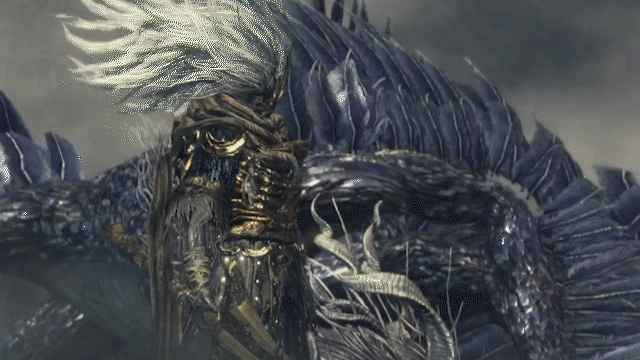 And on the flipside of the Ornstein and Smough interaction, when we kill Ornstein first Smough receives a lightning infusion that is pretty comparable to the power Nameless King appears to inherit through the slaying of his companion. A lot of thought and effort went into making these scenes echo each other, and that absolutely begs the question, "why?" And of course you want an answer, so my current theory is that the dragon is the King of the Storms that the Nameless King must take over for after the dragon's untimely death. The dragon is also Ornstein for reasons, and the Nameless King is filling in for Ornstein's role much in the same way that Imposter Iosefka is attempting to fill in for Original Iosefka. And as for their partnership, we're inclined to think of the Nameless King as being in charge, but much like Executioner's Chariot, "little does he know that is not by his own will that he slays the Undead, but that of his horse." Of course none of this makes sense to you right now, but if I can pull this insane project off, maybe it will in time. Smough's a bit of an enigma. Can't tell if he's supposed to be villainous or sympathetic, or if (predictably) both, what the ratio is and why. For today I think I'll stop there. Upcoming I intend on extending this line of thought to the question of "what exactly is Anor Londo?" Aside from that, I think I'll probably get back to the main playthrough now by moving on to the Duke's Archives of Dark Souls 1. I had to play through earlier than I expected it to get .gif footage, but wow is that place incredible in ways I did not appreciate.
|
|
|
|
Sibyl Disobedience posted:And as for their partnership, we're inclined to think of the Nameless King as being in charge, but much like Executioner's Chariot, "little does he know that is not by his own will that he slays the Undead, but that of his horse." Relatedly, about the equivalences between Lothric and Gwyndolin, the Gwyndolin part of Aldrich's body is apparently just Lothric's model with a fancy hat: https://twitter.com/SHINGGG/status/1054313516113584131
|
|
|
|
Ahahaha...of course it is! Aldrich is just Lothric propping Lorian up so that Lorian can finish their painting! Consuming the God of the Darkmoon indeed...
|
|
|
|
Sibyl Disobedience posted:But one of the most interesting things I've encountered along this line of thinking is a FromSoft game from 2004 called Kuon. It's a survival-horror game roughly in the style of Resident Evil maybe? I haven't personally played it, but I'm considering it because some of the resonance is, well, let's just say when I started suspecting FromSoft was playing a self-referential game with their narratives I wasn't expecting it to have been going on for potentially two or three decades? Sibyl Disobedience posted:Anyway, through some identified mechanism of memetic infection, I suspect this idea crossed over to FromSoft. In Kuon, a 2003 Survival Horror game from FromSoft, the main villain is consuming souls in order to be reborn as a tree. I think there's 10 steps to the process, but I haven't had it in me to stomach the agony of playing PS1/PS2 era games. Anyway, spoiler alert, dude doesn't read the fine print, and the 10th soul he consumes actually consumes him and is reborn as a little girl. Granted, this is the series which put the Moonlight Greatsword specifically from Kingsfield into DS3, so it's not like this sort of thing should be entirely unexpected. In other news, I finally got around to playing Demons' Souls (RPCS3 is a godsend) and wow, From sure does love their internal symbolism, huh? 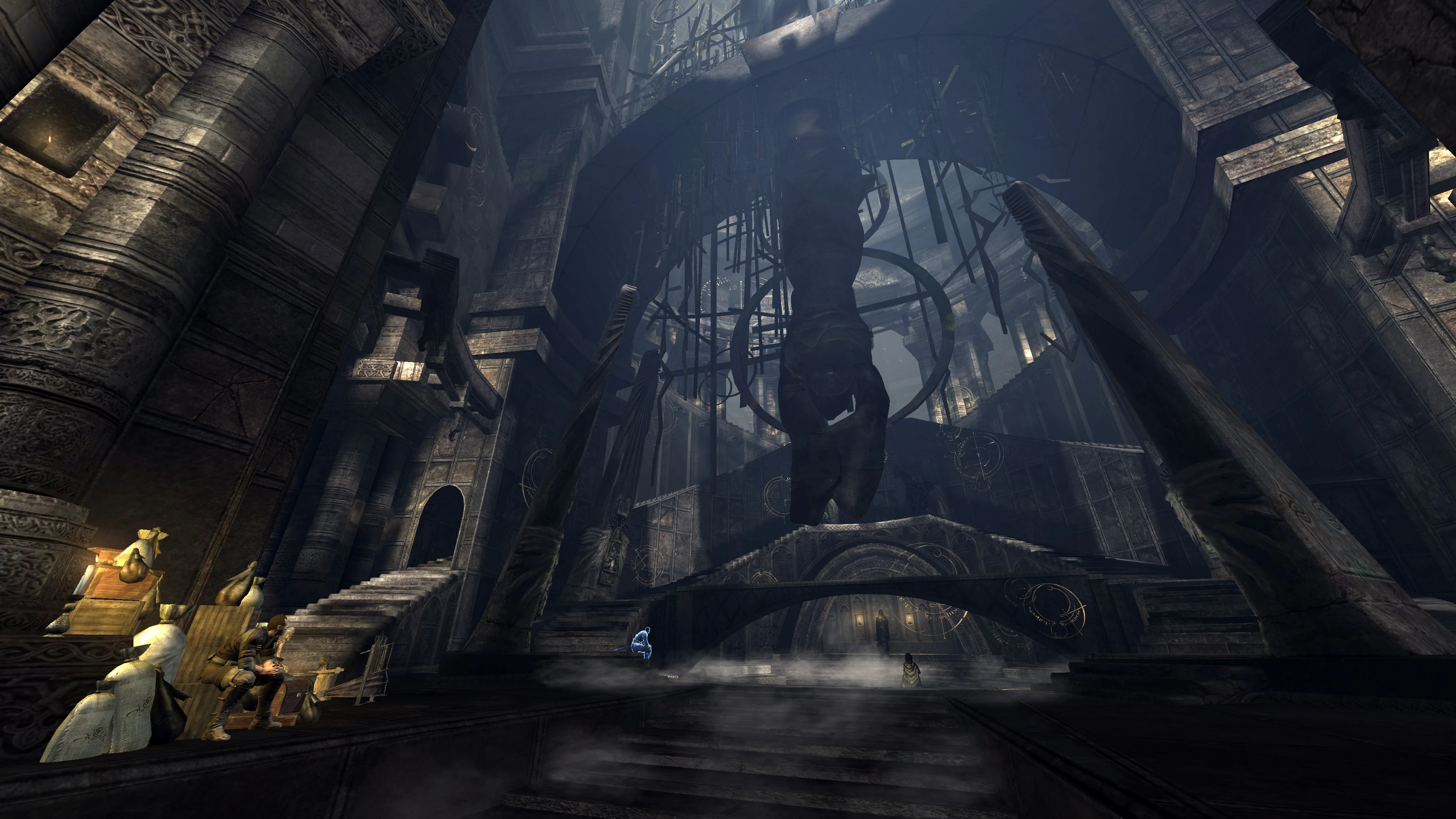 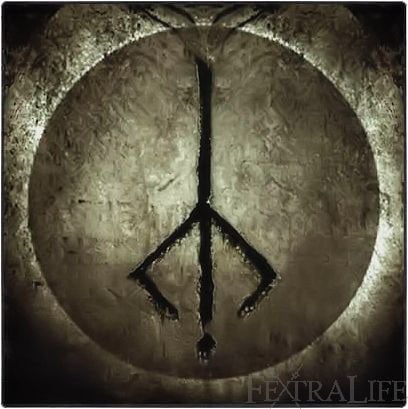  I can already tell I'm gonna love going through it and going "oh what the gently caress, this is where that motif came from?" several times over. (This was probably already mentioned at some point but I'm still catching up on the thread lol)
|
|
|
|
Blaziken386 posted:I know this is from forever back but I saw Kuon mentioned on twitter the other day, and didn't think anything of it. But now it's being brought up here, and my first thought is that this rabbit hole you've unearthed isn't just deep, but in fact, contains entirely new rabbit holes. You have no idea how accurate this statement is. What awaits you on the next page of the thread only just begins to scratch the surface. quote:From sure does love their internal symbolism, huh? Where it gets really fun is when it stops being internal symbolism. For example, Filianore and Astraea share the same core motif, but the original inspiration of the motif? I'm pretty sure I can track it down to 4 separate sources from 1985, 1987, 1994, and 1997, the former three predating FromSoft entirely. Oh, and the places those paths lead...
|
|
|
|
Sorry again for the lack of updates. The next set of videos are pretty enormous, and I'm a bit overwhelmed right now by technical issues, recording problems, and a rather massive increase in the scope of the project from where I even imagined it would end a couple months ago. I'm currently trying to juggle recording three games for use in the third video, and one of these games in particular is, shall we say, not a particularly short playthrough. And the other two are ~30 hours, so... Anyway, I just wanted to give a heads up on where I've been, and also make sure that the thread doesn't get archived in my absence.
|
|
|
|

|
| # ? Apr 20, 2024 00:53 |
|
Sibyl Disobedience posted:Anyway, I just wanted to give a heads up on where I've been, and also make sure that the thread doesn't get archived in my absence. https://forums.somethingawful.com/showthread.php?threadid=3968233&pagenumber=1#post514924454 In any case, it's perfectly understandable that you're taking your time; this project more than deserves all the time it requires 
|
|
|



